A response by Dr. Andrew Vaughn (Executive Director of ASOR) to a lecture at Lanier Theological Library by Dr. Alan Millard (Emeritus Professor and Honorary Senior Fellow, University of Liverpool) entitled, "Did Moses Know the Alphabet? Was There Writing in Ancient Israel?"
"It is quite an honor to be here. I've had the honor & privilege of being on 3 or 4 panels or groups with Prof. Millard, & every time I learned so much. This time I had the task of giving a response without having a manuscript in advance, so it gave me a chance to re-read much of what he's written, & I was reminded how much he knows. Mark [Lanier] told me today, 'Man he knows a lot!' I'm humbled, I must say, to give a response following his lecture, which was very instructive for me."
"I want to make 4 points based on the lecture we've heard, & then conclude with an observation."
"Before that, I want to bring you greetings from the 1,600 members of The American Schools of Oriental Research. Many, almost all of the scholars sitting here are part of our organization. Greetings from the 67 affiliated digs. We have 91 member schools. And Mark Lanier, our host, is on our board, & he is a part of our organization as well. So it's truly an honor to be here, & all of ASOR is glad that we can take part in an event like this. If you're wondering who we are (I have to put in a plug for us), I have some brochures down here, or you can go to www.ASOR.org."
"So my 4 observations, I want to make a few observations about Moses & how he wrote, & all of the observations are going to focus on what I think was an underlying presupposition, that the Israelites in Moses' time had writing that we don't have today; & the reason we don't have that is it was found on papyrus, & not on documents that would have survived. So I'm going to make 4 observations that I think will support the conclusion that there might have been historical sources written on papyrus that have not survived, or we have not found yet."
"I will assume that Moses lived somewhere between 1250 & 1200; I'll narrow down the time in making my observation. I also draw on Gordon Hamilton & Anson Rainey, who've used the names of letters to argue that members of the elite society invented the alphabet. I'm not sure if Prof. Millard agrees on all of that, but I think that's consistent with Moses being trained, having grown up in Pharaoh's court, knowing the alphabet."
"But it comes down to, if cuneiform is preserved, why haven't the papyri been preserved? And that's the point that I want to turn to next."
"One of the texts that Prof. Millard showed us, were some silver amulets from Ketef Hinnom; & I had the privilege of working on these amulets about 12 years ago, & publishing them with 3 other people (Gaby Barkay, Marilyn Lundberg, Bruce Zuckerman). By doing some photographic investigation & looking at the letters, we were able to decipher parts of them that were previously unreadable. And it's actually the parts that are above the Priestly Benediction (the Biblical quote) that I think have the most relevance for positing that there were historical sources that survived."
"One of the quotes that I wrote down from Prof. Millard's lecture was that 'these amulets do not prove the book of Numbers existed at that time.' Another one was, 'Evidence does exist to support the existence of literature at an earlier date.' I'm not sure I got those exactly right, but they're close. I think by going through these 2 amulets, & the confessional statements above the Biblical quotes that are found there, provides evidence that there were historical sources, even if Numbers wasn't written down shortly before the destruction of the first temple. I think there probably was a text there, but I think these amulets show us that this source was a little more fluid."
"So I'm going to read Ketef Hinnom 1, just the translation, mainly the parts above the Biblical quote. It's something like, 'Yahweh the great (& then the text is broken) Who keeps the covenant & graciousness to those who love Him & keep His commandments (then the text is broken), the eternal One (the text is broken again, assumed) is a blessing more than any snare or evil, for redemption is in Him, for the LORD is our restorer & rock. May the LORD bless you, & may He keep you. May the LORD make His face shine (& then the text breaks off).'"
"Notice how much text there is before we get to the Biblical quote, & that these texts are confessional statements."
"Ketef Hinnom 2, it's about the same size, but the writing is much larger so you're not going to get as much text. Also, it has more of the Biblical quote, so you know that both of them were there. It has 'For (the name's broken; ends in) Yahu (so somebody with the name -yahu). May he be blessed by the LORD, the warrior & rebuker of evil. May the LORD bless you & keep you. May the LORD make His face shine upon you, & grant you peace.'"
"So both of these quote this Biblical text, but beforehand they both contain confessional statements about God, showing that this text can be quoted in the late-6th century, & quoted in different ways. I think this is important for the idea that there were historical sources that people could quote, & they were still in flux."
"It's instructive when we look at Numbers 6:22 following, we see the LORD spoke to Moses saying, 'Speak to Aaron & his sons saying, "Thus you shall bless the Israelites; you shall say to them, 'May the LORD bless you & keep you. May the LORD make His face shine upon you, & grant you peace.'"' Notice that the Biblical text doesn't have either one of the confessional statements that we find in these extra-Biblical texts, showing that although it's only a few verses, there was a memory or historical remembrance or a text that had been preserved; & I think that lends credence to the argument that Prof. Millard has made tonight."
"I want to make a few observations on Jerusalem, just a couple. Prof. Millard, who referred to some challenges scholars have made about the united monarchy, & whether it could be strong, given the character of Jerusalem, Prof. Millard said, 'I don't know if "city" was the right word.' In another article, another study, I have built on Albrecht Alt's theory of an administrative center; & I would suggest to you that it's our idea of what a capital city is, that gets in the way of us thinking of Jerusalem as being the head of the united monarchy."
"Alt proposed that Jerusalem was chosen as the neutral administrative center, & was the home only of the king, the king's family, the mercenaries, & the king's army. This led scholars to propose that Jerusalem never spread beyond the Bronze Age city mound, & 12-15 years ago when I wrote my book on Hezekiah, I assumed that Alt was wrong because it was proven that in the 8th century the city had grown beyond those confines. I actually think that my reasoning was faulty now, & that he was right in the 10th century, it was a limited city, but it was our understanding of what a capital city is, that's influenced us in reading the Biblical text. So I would say that 'city' is the right word, but that it's our understanding of what a capital city is."
"An analogy here could be Washington, DC. Before the Civil War, Washington, DC was fairly limited in its size. One of the reasons is, Richmond to the south didn't want Washington, DC to grow. After the Civil War, the federal government didn't care so much what Richmond thought, & there was a natural progression of growth, & Washington, DC grew. I would argue, & I don't want to get too far off here, but that Jerusalem grows after the death of Solomon because it's at that time that there's no longer the need to have a neutral city, because Jerusalem's the capital of the kingdom of Judah in the south."
"So I think all of this is consistent with seeing the united monarchy as being a strong kingdom; & the writing evidence we see from several of the papers we've heard this weekend of writing in the 10th century, is consistent with there being records & historical sources during this time."
"I want to come back to the question of papyri, & could sources have been preserved, & again go back to my book of 12 or 15 years ago on Hezekiah. I wrote on the Chronicler's Account of Hezekiah, & one of the things that I investigated was why the Chronicler's account is much longer than the account in Kings. And some people have proposed that the Chronicler made it up. Well, I questioned this because in other places the Chronicler's account was shorter."
"For example, the Chronicler's account of David leaves out a very important story. If you were going to make David seem better, what one story would you leave out?" [Audience replies, "Bathsheba!"] "Bathsheba. It's not there! The result is, David looks better in Chronicles. Well likewise, what I did was a historical reconstruction of the late-8th century looking at seals & archeology; & all of the historical evidence, I think, showed that Hezekiah undertook prolonged siege preparation, not just of a few years, but built up the kingdom, & that all of this is consistent with the text that we have in Chronicles. It doesn't prove that the Chronicler had a source, but, I think, offers up a certain amount of evidence in support, that the Chronicler had a source that he referred to, & it was probably written on papyrus; & I think this is consistent with other Biblical sources that might have existed & been available during the time of the united monarchy."
"So does all this mean that Moses had a complete, written history? That's hard to say, but I think it is consistent that Moses would have been able to write, Moses would have been able to read, documents would have been written down; when they were codified, or when the text of the Hebrew Bible developed as we have today, is difficult to say. But for me, it's helpful to see the fluid development of the Bible, & how these texts, that are held as sacred texts for many people, developed by, I would say as a person of faith, God inspiring humans to write them."
"I'm going to finish with one story describing a lecture that I heard in seminary. I was in seminary, & the professor gave a talk about the sources in the Pentateuch; & she explained that there were at least 4 sources according to her theory, & I think she's right, that wrote the Pentateuch. The other thing she explained was that nowhere in the Bible did it say that Moses wrote the Pentateuch. It said that it was 'of Moses', but not necessarily written by Moses, & I think Prof. Millard referred to this earlier."
"After the lecture, some of my classmates were asking me, 'Well, what do you think about this? Isn't this disturbing?' I said, 'To tell you the truth, I have to go read my notes over & think about it. This is all new to me; I've never thought about that, but this is really liberating for me.' And they said, 'Why? How could this be liberating for you?' I said, "Well, I've considered myself a pious person, a person of faith, & I've always been a little disappointed that I haven't been pious enough to be put in a trance like Moses, & be told what God is saying.'"
"Since then, I think that the evolution & development of the text shows that God used people like me to write the text, & that it has a more fluid development; & that was helpful for me to see that, yes, there could be historical sources; but like these amulets from Ketef Hinnom, the final version didn't take place until somewhat later. And that, to me, has made the Bible come alive, & not threatened my faith, but rather built it up."
"Thank you."
Although I think Dr. Vaughn did an overall excellent job of responding to Dr. Millard, I have to disagree strongly with his (seminary prof.'s) statement that "nowhere in the Bible did it say that Moses wrote the Pentateuch." 2Chronicles 33:8 (cf. 35:6 & Nehemiah 8:14, 9:14, 10:29) records God referring to "all the Torah ... by the hand of Moses." And that's obvious from Exodus 17:14, 24:4, 34:27, Numbers 33:2, Deuteronomy 31:9, 31:24 (affirmed by Sadducees in Mark 12:19 & Luke 20:28, & by Philip in John 1:45). If it were strictly an oral tradition, God probably would've said "by the mouth of Moses." From these passages, it's safe to say that other phrases translated "the law OF Moses, should be specifically understood as "the law [written for posterity] BY Moses."
I discussed a similar aspect of this subject in depth with John Hobbins back in May, challenging his assertion that "the Pentateuch embeds into its narrative divine prescriptions received in various historical periods and narrativized in terms of reception by Moses." Readers can see that he was not able to defend any of his points without clumsily contradicting himself.
As I wrote on the YouTube page regarding Dr. Vaughn, world-class scholars readily admit when they're wrong (though it may take some time for them to see their problem; me too).
G.M. Grena
Monday, December 24, 2012
Sunday, December 16, 2012
PC Down, Spirit Up
Very frustrating week.
Last Sunday (Dec. 9th), sometime around 1 PM, I had just finished cleaning my weekly task-slate, & took a short break before preparing to write another detailed response to Pithom's "Mailbag" post. I turned off my monitor like usual, & as I was walking out of my living room, I noticed an odd smell of something resembling burnt electronic components crossed with cigarette smoke. I couldn't locate it, so I assumed it came from someone walking past my house where my fresh-air vent is located (but I haven't actually smelled cigarette smoke inside since getting a purification system installed along with a new furnace a couple of years ago).
After about half an hour, I returned to my living room. The odor had diffused, but something else seemed odd. It was quieter & darker ... because my computer had turned off ... which was exceptionally odd because it's plugged into a UPS, which was still on, & I could tell my house had not lost electrical power. Note that unlike other PCs (at home & various places of employment), this one had never acted erratically.
I turned my monitor back on, but it wasn't receiving a signal. To cut to the chase, the fan on my graphics card had frozen, thereby causing other stuff to overheat, which triggered a quiet-but-catastrophic failure. It appears to have taken out the BIOS battery, & done something bad to the hard disk, rendering it unbootable.
After 2 decades of using personal computers at home, this was the best-performing, most-reliable one; but in the end, the shortest-lasting one. I've been able to make smooth transitions between all the others, which have lasted 5-7 years each before becoming so outdated that they were no longer useful.
On Monday I bought a new PC, feeling fortunate that I was able to get a 2012 Windows 7 version of the 2008 Vista one for about the same price ($400); but whereas the old one had 4Gb of RAM & a 640Mb hard drive, this one has 8Gb/1Tb. Best of all, I successfully avoided the dreadful Windows 8 interface, & have now prolonged that agony of converting for a few years (I hope).
I could probably adjust to W8 based on demos I played with in the store while shopping, but I was not in the mood to discover whether any of my old 32-bit applications would run correctly (or at all) on it. Altogether I rely upon 10 programs, several of which have been very helpful in developing & maintaining LMLK tools (for processing images, making drawings, managing LMLK Dotcom, & analyzing statistical data).
I went to bed Monday night thinking I was on the road to a smooth recovery after installing the first couple of applications, but upon waking Tuesday morning I discovered that the PC had frozen. My 2008 Vista had never done that! And it kept doing that each day last week when I arrived home from work, & awoke in the morning (i.e., each time I allowed it to run unattended for more than an hour). Again, to cut to the chase, after more trials & errors than with any other new PC/OS, yesterday I finally got it to run stable, & I'm optimistic that the problems have been resolved.
Also, after some trepidation due to some of my applications failing to install or crashing after "successful" installations, all of them appear to be running okay. Just a little while ago this evening I did the last one, which is my main camera that I can control remotely for efficient seal-impression photography using multiple lighting angles. I took a sample photo of my touchy-feely 1948 LMLK FDC envelope, & was thrilled to close the week out on this positive note.
Putting aside the birth pains, I'm very pleased by the performance of this PC, especially since it handles overly complicated web pages (such as eBay) really well. I was also able to recover all of my files from the non-bootable disk. Now I can continue living!
One bright spot in the midst of last week's perils, was getting to attend another local lecture by Ken Ham at Calvary Chapel, Costa Mesa, which is pastored by Chuck Smith (who led the communion service on this occasion). This was a special occasion for both of us, because it was one of the churches at which he lectured during his first visit to America 25 years ago; & it was the first place where I saw him in person almost 7 years ago.
Mr. Ham entitled his lecture, "How to Communicate the Gospel in an Increasingly Secularized America." Less than a week after returning from a refreshing vacation in his native Australia, he gave an exceptionally passionate, flawless delivery.
Afterwards I had the privilege of serving at one of the media-sales tables, this one being cash-only. Wow! What a blessing to see so many people lining up & holding out money to buy AiG resources! The last time I handled so much moola in such a short time was ... well, let's not go there! It was fun but frustrating having to do rapid-fire arithmetic on the fly (making change for various discounts). You can imagine what an additional privilege it was when Mr. Ham entrusted some of his personal belongings to my care while he mingled among the crowd!
G.M. Grena
Last Sunday (Dec. 9th), sometime around 1 PM, I had just finished cleaning my weekly task-slate, & took a short break before preparing to write another detailed response to Pithom's "Mailbag" post. I turned off my monitor like usual, & as I was walking out of my living room, I noticed an odd smell of something resembling burnt electronic components crossed with cigarette smoke. I couldn't locate it, so I assumed it came from someone walking past my house where my fresh-air vent is located (but I haven't actually smelled cigarette smoke inside since getting a purification system installed along with a new furnace a couple of years ago).
After about half an hour, I returned to my living room. The odor had diffused, but something else seemed odd. It was quieter & darker ... because my computer had turned off ... which was exceptionally odd because it's plugged into a UPS, which was still on, & I could tell my house had not lost electrical power. Note that unlike other PCs (at home & various places of employment), this one had never acted erratically.
I turned my monitor back on, but it wasn't receiving a signal. To cut to the chase, the fan on my graphics card had frozen, thereby causing other stuff to overheat, which triggered a quiet-but-catastrophic failure. It appears to have taken out the BIOS battery, & done something bad to the hard disk, rendering it unbootable.
After 2 decades of using personal computers at home, this was the best-performing, most-reliable one; but in the end, the shortest-lasting one. I've been able to make smooth transitions between all the others, which have lasted 5-7 years each before becoming so outdated that they were no longer useful.
On Monday I bought a new PC, feeling fortunate that I was able to get a 2012 Windows 7 version of the 2008 Vista one for about the same price ($400); but whereas the old one had 4Gb of RAM & a 640Mb hard drive, this one has 8Gb/1Tb. Best of all, I successfully avoided the dreadful Windows 8 interface, & have now prolonged that agony of converting for a few years (I hope).
I could probably adjust to W8 based on demos I played with in the store while shopping, but I was not in the mood to discover whether any of my old 32-bit applications would run correctly (or at all) on it. Altogether I rely upon 10 programs, several of which have been very helpful in developing & maintaining LMLK tools (for processing images, making drawings, managing LMLK Dotcom, & analyzing statistical data).
I went to bed Monday night thinking I was on the road to a smooth recovery after installing the first couple of applications, but upon waking Tuesday morning I discovered that the PC had frozen. My 2008 Vista had never done that! And it kept doing that each day last week when I arrived home from work, & awoke in the morning (i.e., each time I allowed it to run unattended for more than an hour). Again, to cut to the chase, after more trials & errors than with any other new PC/OS, yesterday I finally got it to run stable, & I'm optimistic that the problems have been resolved.
Also, after some trepidation due to some of my applications failing to install or crashing after "successful" installations, all of them appear to be running okay. Just a little while ago this evening I did the last one, which is my main camera that I can control remotely for efficient seal-impression photography using multiple lighting angles. I took a sample photo of my touchy-feely 1948 LMLK FDC envelope, & was thrilled to close the week out on this positive note.
Putting aside the birth pains, I'm very pleased by the performance of this PC, especially since it handles overly complicated web pages (such as eBay) really well. I was also able to recover all of my files from the non-bootable disk. Now I can continue living!
One bright spot in the midst of last week's perils, was getting to attend another local lecture by Ken Ham at Calvary Chapel, Costa Mesa, which is pastored by Chuck Smith (who led the communion service on this occasion). This was a special occasion for both of us, because it was one of the churches at which he lectured during his first visit to America 25 years ago; & it was the first place where I saw him in person almost 7 years ago.
Mr. Ham entitled his lecture, "How to Communicate the Gospel in an Increasingly Secularized America." Less than a week after returning from a refreshing vacation in his native Australia, he gave an exceptionally passionate, flawless delivery.
Afterwards I had the privilege of serving at one of the media-sales tables, this one being cash-only. Wow! What a blessing to see so many people lining up & holding out money to buy AiG resources! The last time I handled so much moola in such a short time was ... well, let's not go there! It was fun but frustrating having to do rapid-fire arithmetic on the fly (making change for various discounts). You can imagine what an additional privilege it was when Mr. Ham entrusted some of his personal belongings to my care while he mingled among the crowd!
G.M. Grena
Sunday, November 25, 2012
Chick-fil-A and Droopy Dog
It's official: Chick-fil-A belongs to The King!

Okay, I confess that I didn't see the two "484" occurrences until I looked at the receipt this morning while taking the survey. But I'll take advantage of any trivial incident as an opportunity to write about a Heritage Singers show!
I happened to stop at this Chick-fil-A on the way to the annual concert at Loma Linda University Church. In addition to celebrating my 1-year anniversary of becoming an HS fan, this was an extra-special occasion because it was the first time in many years (the 2005 35th-anniversary show?) they utilized a live (6-member) band for an American concert rather than simply pre-recorded orchestration. Here's the full line-up plus set-list:
Aside from getting to hear how the band blended with the pre-recorded tracks, highlights for me were getting to hear the first-ever (?) live performances of "One Fine Day" (from a 2005 album) & "The Savior..." (from their current album). Highlights for the general audience, based upon their standing ovations, were "The Prayer" & "I Bowed..."
Afterwards I was able to chat with Art about an obscure track from their 1986 album ("Right Now"), "Summer of '84". As this was the turning point in my life between graduating from university & moving to California for full-time engineering employment, & since it was only the 2nd instrumental song HS recorded, naturally I was curious. It turned out to be another HS original, composed primarily by longtime keyboardist Dani Stromback (who performs regularly at their European shows).
Next I met with Tim Davis, who has played a major role in HS musical arrangements for many years, & who works in the secular industry recording session soundtracks & commercial jingles. Earlier this year I found a special video on YouTube of Tim presenting his Christian testimony prior to singing "His Heart Is Big Enough" (from the 1994 Peacespeaker album tour). Less than a minute into his 8-minute speech, he does a funny imitation of the Droopy cartoon dog, a great example of Tim's humorous personality:
After asking him to autograph my HS book, I told him I was going to prove to him that I had become a genuine HS fan. I really don't have the skill to sing or imitate voices, but I've been practicing that winners-never-cheat line as best I could in the hope I'd get to make Tim laugh, & I succeeded! He got a kick out of it because it was from such a long time ago. The element of surprise!
And of course I had the privilege of chatting again with the HS founders, Mr. & Mrs. Mace. Overall it was a blessed night. So much joy! Such a great occasion to praise God & be thankful for life, & for the promise of so much more to come throughout eternity with the family of God. Get used to it!
G.M. Grena

Okay, I confess that I didn't see the two "484" occurrences until I looked at the receipt this morning while taking the survey. But I'll take advantage of any trivial incident as an opportunity to write about a Heritage Singers show!
I happened to stop at this Chick-fil-A on the way to the annual concert at Loma Linda University Church. In addition to celebrating my 1-year anniversary of becoming an HS fan, this was an extra-special occasion because it was the first time in many years (the 2005 35th-anniversary show?) they utilized a live (6-member) band for an American concert rather than simply pre-recorded orchestration. Here's the full line-up plus set-list:
- Max Mace
- Shani Diehl
- Tim Calhoun
- Melody Davis
- Tim Davis
- Val Mace-Mapa
- Dave Bell
- Austin Mapa (percussion)
- Art Mapa (guitar)
- Jesper Kristensen (drums)
- Joel Umali (piano)
- Nino Ocampo (bass)
- Sergio Leiva (organ)
- O Happy Day / Nothing But the Blood
- Hey
- Jesus Is All I Need
- I Believe in a Hill Called Mount Calvary
- Child Forgiven
- Holy Spirit Rain Down
- The Lighthouse
- One Fine Day
- (testimony by Shani referencing Max Lucado's blog)
- Home
- Yes I Am
- The Prayer
- Song of Glory
- I Am Not Ashamed of the Gospel
- (offering speech by LLU Pastor Randy Roberts)
- Hosanna
- (HS member introductions)
- This Old House
- What a Day That Will Be
- In Awe
- Strike Up the Band
- The Savior Is Waiting
- I Bowed on My Knees & Cried Holy
Aside from getting to hear how the band blended with the pre-recorded tracks, highlights for me were getting to hear the first-ever (?) live performances of "One Fine Day" (from a 2005 album) & "The Savior..." (from their current album). Highlights for the general audience, based upon their standing ovations, were "The Prayer" & "I Bowed..."
Afterwards I was able to chat with Art about an obscure track from their 1986 album ("Right Now"), "Summer of '84". As this was the turning point in my life between graduating from university & moving to California for full-time engineering employment, & since it was only the 2nd instrumental song HS recorded, naturally I was curious. It turned out to be another HS original, composed primarily by longtime keyboardist Dani Stromback (who performs regularly at their European shows).
Next I met with Tim Davis, who has played a major role in HS musical arrangements for many years, & who works in the secular industry recording session soundtracks & commercial jingles. Earlier this year I found a special video on YouTube of Tim presenting his Christian testimony prior to singing "His Heart Is Big Enough" (from the 1994 Peacespeaker album tour). Less than a minute into his 8-minute speech, he does a funny imitation of the Droopy cartoon dog, a great example of Tim's humorous personality:
After asking him to autograph my HS book, I told him I was going to prove to him that I had become a genuine HS fan. I really don't have the skill to sing or imitate voices, but I've been practicing that winners-never-cheat line as best I could in the hope I'd get to make Tim laugh, & I succeeded! He got a kick out of it because it was from such a long time ago. The element of surprise!
And of course I had the privilege of chatting again with the HS founders, Mr. & Mrs. Mace. Overall it was a blessed night. So much joy! Such a great occasion to praise God & be thankful for life, & for the promise of so much more to come throughout eternity with the family of God. Get used to it!
G.M. Grena
Monday, November 19, 2012
Far-reaching Clarifications
When I awoke this morning, it dawned on me that this sentence I wrote in last night's blog post is wrong/misleading:
"I find it amazing that [the northern (Israelite) LMLKs] have not even been noted in this TA series of articles."
Actually they were noted by Lipschits et al.; however, what I sub-consciously meant was that they were not taken into consideration for the primary subject, which is the chronology of the LMLK stamp impressions as a tool for studying the history of late monarchic Judah. To be thorough, here are the exact quotations:
Tel Aviv 37 #1 p. 15: "Stamp impressions of [type M2D] were also found at ... Tel Jezreel and Khirbet Sharta (Qiryat Ata / Kefar Ata), all of them located outside the boundaries of the Kingdom of Judah. (See the data gathered by Garena [sic] (http://www.lmlk.com/research/lmlk_m2d.htm), with further literature.)"
Tel Aviv 38 #1 p. 10 (Table 1) & redundantly on p. 30 (Table 2) with respective footnotes 39 & 40 on p. 35: "Outside Judahite Territory: En Tut (http://www.hadashot-esi.org.il/report_detail.asp?id=1412&mag_id=117), Mt. Meiron (For this impression see Meyers and Meyers (1990: 126, Pl. D: 1). The drawing of the stamp impression is blurred and not detailed, making it impossible to identify its exact type or even to know if it is indeed an lmlk stamp impression.)"
To his credit, David Ussishkin hinted at the issue in his rejoinder:
Tel Aviv 38 #2 p. 222: "How is it that similar systems were not introduced in northern Israel or the kingdoms of Syria that fell under the Assyrian orbit about the same time as Judah?"
Turning to my BibleInterp response, here's what the TAU scholars need to take into consideration, especially when discussing methodology as Dr. Finkelstein recently did:
"If anything, the jars argue against an outsider/Assyrian connection, unless you believe there were numerous Assyrians stationed at, or frequently visiting, small farming sites as well as large towns during Hezekiah's reign. If so, where is the evidence, and more importantly, why are there so few in the northern territory, which was thoroughly conquered by Assyria? Did the Assyrians not care about the economy in those regions they conquered? ... 2Kings/Isaiah and 2Chronicles present Hezekiah as both a religious and political rebel, a bold leader who attempted to unify the northern kingdom of Israel with his southern kingdom of Judah, rebelling against Assyria (albeit with a brief burst of infidelity when he made a tribute payment to Sennacherib at Lachish). This interpretation of history stands in complete contrast to that presented by Lipschits et al., where Hezekiah inherits the Assyrian vassal kingdom from his father, Ahaz, and remains mostly subservient, like a bird in a cage."
Also, I should have linked to Dr. van der Veen's Academia site, wherein he provides this abstract to a paper published in Journal of the Ancient Chronology Forum vol. 10 (2005):
"In this paper a summary is given of seal evidence presented in my thesis, but also deals with other evidence that appears to suggest that a moderate lowering of Iron Age dates is in order: e.g. lammelek jar handles (especially those with the 2-winged symbol) continued to be produced after 701 BC (i.e. after the destruction of Lachish in 701 B.C. by Sennacherib). This is especially clear from sites that continued to flourish after Sennacherib's invasion of Judah (e.g. Jerusalem, one period sites such as Horvat Shilha, as well as sites that were probably not founded before 650 BC such as Tel Goren (Str. V). This case has been argued previously by E. Stern (2001) and G. Grena (2004 and in subsequent articles), and only recently by Oded Lipschits et al (2010, 2011)."
Here is his published quotation from p. 51 (w/ bibliographical footnote #22 from p. 56):
"Contrary to G. Barkay and A. Vaughn's suggestion that all royal stamps originated before the end of 'Lachish III' (conventionally late 8th century), evidence now increases that the two-winged type continues into the late 7th century BC (e.g., at Tel Goren V, Khirbet es Samra, H. Shilha; esp. P.G. van der Veen, "The Final Phase of Iron Age IIC and the Babylonian Conquest [PhD thesis, Bristol 2005, scheduled for publication through Eisenbrauns, Winona Lake, USA], pp. 128ff.; G. Grena, "LMLK--A Mystery Belonging to the King [Redondo Beach 2004], pp. 333ff.)."
On a related note, in case anyone claims that the TAU writers were not obligated to cite van der Veen's unpublished thesis, they're correct; however, notice these other "forthcoming" publication citations used by the TAU writers:
TA 37 #1, p. 9: "Of these, 132 were incised on the same handle and next to
the lmlk stamp impressions (Lipschits, Sergi and Koch forthcoming)."
TA 37 #1, p. 11, f/n 15: "Five were found at Ramat Raḥel (Aharoni 1962: 19, Fig. 15: 8; 1964: 34, Pl. 39: 4–5; Sergi forthcoming a, forthcoming b)."
TA 37 #1, p. 14, f/n 17: "At Ramat Raḥel 35 were discovered (Aharoni 1962: 19–20, 47, Fig. 15: 5; 1964: 34, 62–63, Pls. 38: 10–12, 39: 1–2; Sergi forthcoming a, forthcoming b)."
TA 37 #1, p. 14, f/n 19: "Eighteen were found at Ramat Raḥel (Aharoni 1962: 47, Fig. 15: 6, Pl. 7: 5; 1964: 62– 63, Pl. 38: 7– 9; Sergi forthcoming a, forthcoming b)."
TA 37 #1, p. 15, f/n 22: "At Ramat Raḥel 20 stamp impressions of this type were retrieved (Aharoni 1962: 47; 1964: 62–63, Pl. 39: 8–11; Sergi forthcoming a, forthcoming b)."
TA 37 #1, p. 16, f/n 28: "See Sergi forthcoming a, forthcoming b; Pritchard 1959: 25, Nos. 75, 412, 414, 453; Sinclair 1960: 32, Pl. 166: 3; Avigad and Barkay 2000: Nos. 24–26 pp. 252, 261; Shoham 2000: 76, Nos. 29–30, Pl. 2: 29–30."
TA 37 #1, p. 19: "Only 40 stamp impressions are dated to the 8th century (28% of the total recognizable finds) as against 102 dated to the 7th century (72%) (Sergi forthcoming a, forthcoming b)."
TA 37 #1, p. 27, Table 4, index #43: "1, Ramat Rahel, Lipschits forthcoming."
TA 38 #1, p. 5: "Furthermore, the same administrative system continued after the 586 BCE destruction for an additional 450 years, during the Babylonian period (the mwsh and lion stamped handles; see Lipschits 2010), during the Persian and the Early Hellenistic periods (the yhwd stamped handles; see Vanderhooft and Lipschits 2007; Lipschits and Vanderhooft forthcoming) and until the Late Hellenistic period (the late yhwd and the yrslm stamped handles; see Ariel and Shoham 2000: 159–163, with further literature; Vanderhooft and Lipschits 2007)."
TA 38 #1, p. 6: "We assume that in addition to Jerusalem, the few sites that yielded large quantities of stamped handles (mainly Lachish and Ramat Raḥel) served as major collection centres, while sites that yielded up to a few dozen stamped handles served as secondary administrative centres (Lipschits and Vanderhooft forthcoming)."
Also unpublished personal communication:
TA 38 #1, p. 14: "The settlement pattern in the Beersheba–Arad Valleys included four fortified towns: Tel >Ira VII (Beit Arieh 1999: 170–173), >Aroer III (Thareani 2010: 55–271), Tel Malúata IV (Kochavi 1993: 935–936; I. Beit-Arieh, personal communication) and probably biblical Beersheba (Bir es-Seba) (Panitz-Cohen 2005)."
TA 38 #1, p. 19, f/n 10: "The excavators of the site accepted this suggestion as well (L. Freud, personal communication)."
TA 38 #1, p. 20: "The region did not thrive during this period, but there are some clues for the existence of a town at Tel Malúata (I. Beit-Arieh, personal communication) and the caravanserai at >Aroer (Thareani-Sussely 2007b; Thareani 2010)."
Oh, & I also forgot to reiterate that my 2004 book & van der Veen's 2005 thesis had already been cited by another scholar (Peter James) in another prestigious academic journal, Palestine Exploration Quarterly vol. 139 #3, p. 215:
"Yet, as Mazar and others have frequently pointed out, lmlk jars are found at many sites (such as Tel Batash) in strata deemed to be 7th century (see e.g. Mazar, Amit and Ilan 1996, 208-209; Grena 2004, 333-338; van der Veen forthcoming, Excursus 1), including a number of one-period settlements."
If my 2004 book & Dr. van der Veen's 2005 thesis were not known at Tel Aviv University until this year, they definitely are now, & for that I'm grateful. The secret's out...
G.M. Grena
"I find it amazing that [the northern (Israelite) LMLKs] have not even been noted in this TA series of articles."
Actually they were noted by Lipschits et al.; however, what I sub-consciously meant was that they were not taken into consideration for the primary subject, which is the chronology of the LMLK stamp impressions as a tool for studying the history of late monarchic Judah. To be thorough, here are the exact quotations:
Tel Aviv 37 #1 p. 15: "Stamp impressions of [type M2D] were also found at ... Tel Jezreel and Khirbet Sharta (Qiryat Ata / Kefar Ata), all of them located outside the boundaries of the Kingdom of Judah. (See the data gathered by Garena [sic] (http://www.lmlk.com/research/lmlk_m2d.htm), with further literature.)"
Tel Aviv 38 #1 p. 10 (Table 1) & redundantly on p. 30 (Table 2) with respective footnotes 39 & 40 on p. 35: "Outside Judahite Territory: En Tut (http://www.hadashot-esi.org.il/report_detail.asp?id=1412&mag_id=117), Mt. Meiron (For this impression see Meyers and Meyers (1990: 126, Pl. D: 1). The drawing of the stamp impression is blurred and not detailed, making it impossible to identify its exact type or even to know if it is indeed an lmlk stamp impression.)"
To his credit, David Ussishkin hinted at the issue in his rejoinder:
Tel Aviv 38 #2 p. 222: "How is it that similar systems were not introduced in northern Israel or the kingdoms of Syria that fell under the Assyrian orbit about the same time as Judah?"
Turning to my BibleInterp response, here's what the TAU scholars need to take into consideration, especially when discussing methodology as Dr. Finkelstein recently did:
"If anything, the jars argue against an outsider/Assyrian connection, unless you believe there were numerous Assyrians stationed at, or frequently visiting, small farming sites as well as large towns during Hezekiah's reign. If so, where is the evidence, and more importantly, why are there so few in the northern territory, which was thoroughly conquered by Assyria? Did the Assyrians not care about the economy in those regions they conquered? ... 2Kings/Isaiah and 2Chronicles present Hezekiah as both a religious and political rebel, a bold leader who attempted to unify the northern kingdom of Israel with his southern kingdom of Judah, rebelling against Assyria (albeit with a brief burst of infidelity when he made a tribute payment to Sennacherib at Lachish). This interpretation of history stands in complete contrast to that presented by Lipschits et al., where Hezekiah inherits the Assyrian vassal kingdom from his father, Ahaz, and remains mostly subservient, like a bird in a cage."
Also, I should have linked to Dr. van der Veen's Academia site, wherein he provides this abstract to a paper published in Journal of the Ancient Chronology Forum vol. 10 (2005):
"In this paper a summary is given of seal evidence presented in my thesis, but also deals with other evidence that appears to suggest that a moderate lowering of Iron Age dates is in order: e.g. lammelek jar handles (especially those with the 2-winged symbol) continued to be produced after 701 BC (i.e. after the destruction of Lachish in 701 B.C. by Sennacherib). This is especially clear from sites that continued to flourish after Sennacherib's invasion of Judah (e.g. Jerusalem, one period sites such as Horvat Shilha, as well as sites that were probably not founded before 650 BC such as Tel Goren (Str. V). This case has been argued previously by E. Stern (2001) and G. Grena (2004 and in subsequent articles), and only recently by Oded Lipschits et al (2010, 2011)."
Here is his published quotation from p. 51 (w/ bibliographical footnote #22 from p. 56):
"Contrary to G. Barkay and A. Vaughn's suggestion that all royal stamps originated before the end of 'Lachish III' (conventionally late 8th century), evidence now increases that the two-winged type continues into the late 7th century BC (e.g., at Tel Goren V, Khirbet es Samra, H. Shilha; esp. P.G. van der Veen, "The Final Phase of Iron Age IIC and the Babylonian Conquest [PhD thesis, Bristol 2005, scheduled for publication through Eisenbrauns, Winona Lake, USA], pp. 128ff.; G. Grena, "LMLK--A Mystery Belonging to the King [Redondo Beach 2004], pp. 333ff.)."
On a related note, in case anyone claims that the TAU writers were not obligated to cite van der Veen's unpublished thesis, they're correct; however, notice these other "forthcoming" publication citations used by the TAU writers:
TA 37 #1, p. 9: "Of these, 132 were incised on the same handle and next to
the lmlk stamp impressions (Lipschits, Sergi and Koch forthcoming)."
TA 37 #1, p. 11, f/n 15: "Five were found at Ramat Raḥel (Aharoni 1962: 19, Fig. 15: 8; 1964: 34, Pl. 39: 4–5; Sergi forthcoming a, forthcoming b)."
TA 37 #1, p. 14, f/n 17: "At Ramat Raḥel 35 were discovered (Aharoni 1962: 19–20, 47, Fig. 15: 5; 1964: 34, 62–63, Pls. 38: 10–12, 39: 1–2; Sergi forthcoming a, forthcoming b)."
TA 37 #1, p. 14, f/n 19: "Eighteen were found at Ramat Raḥel (Aharoni 1962: 47, Fig. 15: 6, Pl. 7: 5; 1964: 62– 63, Pl. 38: 7– 9; Sergi forthcoming a, forthcoming b)."
TA 37 #1, p. 15, f/n 22: "At Ramat Raḥel 20 stamp impressions of this type were retrieved (Aharoni 1962: 47; 1964: 62–63, Pl. 39: 8–11; Sergi forthcoming a, forthcoming b)."
TA 37 #1, p. 16, f/n 28: "See Sergi forthcoming a, forthcoming b; Pritchard 1959: 25, Nos. 75, 412, 414, 453; Sinclair 1960: 32, Pl. 166: 3; Avigad and Barkay 2000: Nos. 24–26 pp. 252, 261; Shoham 2000: 76, Nos. 29–30, Pl. 2: 29–30."
TA 37 #1, p. 19: "Only 40 stamp impressions are dated to the 8th century (28% of the total recognizable finds) as against 102 dated to the 7th century (72%) (Sergi forthcoming a, forthcoming b)."
TA 37 #1, p. 27, Table 4, index #43: "1, Ramat Rahel, Lipschits forthcoming."
TA 38 #1, p. 5: "Furthermore, the same administrative system continued after the 586 BCE destruction for an additional 450 years, during the Babylonian period (the mwsh and lion stamped handles; see Lipschits 2010), during the Persian and the Early Hellenistic periods (the yhwd stamped handles; see Vanderhooft and Lipschits 2007; Lipschits and Vanderhooft forthcoming) and until the Late Hellenistic period (the late yhwd and the yrslm stamped handles; see Ariel and Shoham 2000: 159–163, with further literature; Vanderhooft and Lipschits 2007)."
TA 38 #1, p. 6: "We assume that in addition to Jerusalem, the few sites that yielded large quantities of stamped handles (mainly Lachish and Ramat Raḥel) served as major collection centres, while sites that yielded up to a few dozen stamped handles served as secondary administrative centres (Lipschits and Vanderhooft forthcoming)."
Also unpublished personal communication:
TA 38 #1, p. 14: "The settlement pattern in the Beersheba–Arad Valleys included four fortified towns: Tel >Ira VII (Beit Arieh 1999: 170–173), >Aroer III (Thareani 2010: 55–271), Tel Malúata IV (Kochavi 1993: 935–936; I. Beit-Arieh, personal communication) and probably biblical Beersheba (Bir es-Seba) (Panitz-Cohen 2005)."
TA 38 #1, p. 19, f/n 10: "The excavators of the site accepted this suggestion as well (L. Freud, personal communication)."
TA 38 #1, p. 20: "The region did not thrive during this period, but there are some clues for the existence of a town at Tel Malúata (I. Beit-Arieh, personal communication) and the caravanserai at >Aroer (Thareani-Sussely 2007b; Thareani 2010)."
Oh, & I also forgot to reiterate that my 2004 book & van der Veen's 2005 thesis had already been cited by another scholar (Peter James) in another prestigious academic journal, Palestine Exploration Quarterly vol. 139 #3, p. 215:
"Yet, as Mazar and others have frequently pointed out, lmlk jars are found at many sites (such as Tel Batash) in strata deemed to be 7th century (see e.g. Mazar, Amit and Ilan 1996, 208-209; Grena 2004, 333-338; van der Veen forthcoming, Excursus 1), including a number of one-period settlements."
If my 2004 book & Dr. van der Veen's 2005 thesis were not known at Tel Aviv University until this year, they definitely are now, & for that I'm grateful. The secret's out...
G.M. Grena
Sunday, November 18, 2012
Far-reaching Implications
For some strange reason, I no longer see any info (contents, abstracts, editorial) for the current issue of Tel Aviv Journal (vol. 39, #2, Nov. 2012) on IngentaConnect's TAV page. Nonetheless, I'm going to let the editor, Professor Israel Finkelstein, do some more guest blogging by way of published quotations (I had considered titling this post "Son of Finkelstein", but I wanted to emphasize the importance of the occasion with the title I chose). Here's the abstract from Dr. Finkelstein's freshly pressed article, "Comments on the Date of Late-Monarchic Judahite Seal Impressions" (pp. 75-83):
"The article is a rejoinder to the recent discussion on the date of late-monarchic (Iron IIB-C) Judahite seal impressions (Lipschits, Sergi and Koch 2010; 2011; Koch and Lipschits 2010; Ussishkin 2011; Lipschits 2012). It contends with two main issues: (1) Methodological observations regarding the transition from the Iron IIB to the Iron IIC pottery horizons in Judah and their implications for the date of the lmlk seal impressions; (2) The date of appearance of the rosette seal impressions and its implications for the 'archaeology of the days of Manasseh' paradigm. The author agrees with Lipschits et al.'s early 7th century dating of the late lmlk seal impressions, but would place the transition from the concentric incisions to the rosette impressions somewhat before the middle of the 7th century BCE, in the days of King Manasseh."
He begins by listing the 4 chronological phases of Lipschits, Sergi, Koch:
For item #2 (after his "7the" typo), he cites my LMLKv1 book: "already Grena 2004: 338"! (Note that I had informally written about this in 2002.) Here's a screenshot of his Bibliography showing my book (& yes, I'm totally gloating over this milestone in my life):
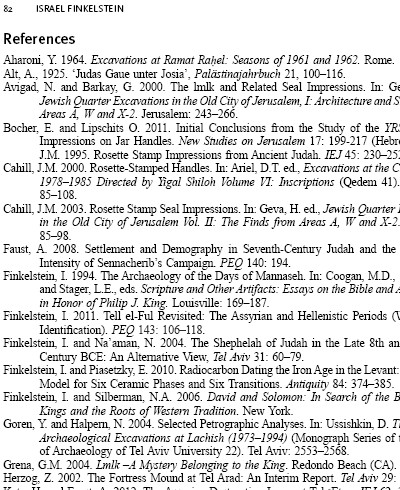
Although this screenshot ends after my book, the rest of the Bibliography unfortunately does not include Dr. P.G. van der Veen's 2005 dissertation, "The Final Phase of Iron Age IIC and the Babylonian Conquest – A Re-Assessment with Special Emphasis on Names and Bureaucratic Titles on Provenanced Seals and Bullae from Israel and Jordan", University of Bristol (forthcoming, Alter Orient und Altes Testament Series, Munster: Ugarit-Verlag), in which he was the first academician to formally acknowledge my work.
Following these 4 phases, Finkelstein mentions Dr. Ussishkin's 2011 rejoinder, & makes this profound declaration:
"This debate has far-reaching implications for the history of Judah in particular and the region in general in the late Iron II, ca. 730–586 BCE."
Except for the 730-586 date range (which I've been planning to deal with in depth in LMLKv2), I agree wholeheartedly with him on this point! So which side does he favor?
"I leave it to Lipschits, Sergi and Koch to struggle with the details of Ussishkin's arguments (2011)."
Deliberately ignoring my Bible & Interpretation rebuttals in this debate, he promptly proceeds to struggle with some of the details of Ussishkin's arguments, beginning with Lachish, then visiting Beer-sheba, Arad, 'Aroer, all of which "seems to support Lipschits, Sergi and Koch contra Ussishkin". Data from Tel 'Eton, on the other hand "may support Ussishkin contra Lipschits, Sergi and Koch". Moving to the Buqeia Valley & En Gedi, he again argues against Ussishkin by saying he sees "no clear-cut evidence that [they were] inhabited in the 8th century".
Horvat Shilhah becomes the deciding factor, which he describes as "the smoking gun for the dating of the late lmlk impressions in the 7th century". Many bloggers have remarked on the increasing excavation activity in the Shephelah. I believe that as more scholars realize the importance of these desert sites, we'll see a shift into that region ... if extensive excavation there is possible.
As I mentioned to Dr. Lipschits at ASOR/SBL in 2007, Dr. Finkelstein still needs to address the northern (Israelite) LMLKs. I find it amazing that they have not even been noted in this TA series of articles. Since the region east & northeast of Jerusalem has remained somewhat unpopular for archeological work mainly due to hostile Palestinians, the shift in popularity from the Shephelah may move to northern Israel first ... assuming that more excavation directors recognize the implications of this debate ... & that it doesn't take another 10 years to reach them!
G.M. Grena
"The article is a rejoinder to the recent discussion on the date of late-monarchic (Iron IIB-C) Judahite seal impressions (Lipschits, Sergi and Koch 2010; 2011; Koch and Lipschits 2010; Ussishkin 2011; Lipschits 2012). It contends with two main issues: (1) Methodological observations regarding the transition from the Iron IIB to the Iron IIC pottery horizons in Judah and their implications for the date of the lmlk seal impressions; (2) The date of appearance of the rosette seal impressions and its implications for the 'archaeology of the days of Manasseh' paradigm. The author agrees with Lipschits et al.'s early 7th century dating of the late lmlk seal impressions, but would place the transition from the concentric incisions to the rosette impressions somewhat before the middle of the 7th century BCE, in the days of King Manasseh."
He begins by listing the 4 chronological phases of Lipschits, Sergi, Koch:
- "Early" LMLKs (late 8th century)
- "Late" LMLKs (early 7the [sic] century)
- "Concentric incisions" (mid-7th century)
- Rosettes (late 7th & early 6th centuries)
For item #2 (after his "7the" typo), he cites my LMLKv1 book: "already Grena 2004: 338"! (Note that I had informally written about this in 2002.) Here's a screenshot of his Bibliography showing my book (& yes, I'm totally gloating over this milestone in my life):

Although this screenshot ends after my book, the rest of the Bibliography unfortunately does not include Dr. P.G. van der Veen's 2005 dissertation, "The Final Phase of Iron Age IIC and the Babylonian Conquest – A Re-Assessment with Special Emphasis on Names and Bureaucratic Titles on Provenanced Seals and Bullae from Israel and Jordan", University of Bristol (forthcoming, Alter Orient und Altes Testament Series, Munster: Ugarit-Verlag), in which he was the first academician to formally acknowledge my work.
Following these 4 phases, Finkelstein mentions Dr. Ussishkin's 2011 rejoinder, & makes this profound declaration:
"This debate has far-reaching implications for the history of Judah in particular and the region in general in the late Iron II, ca. 730–586 BCE."
Except for the 730-586 date range (which I've been planning to deal with in depth in LMLKv2), I agree wholeheartedly with him on this point! So which side does he favor?
"I leave it to Lipschits, Sergi and Koch to struggle with the details of Ussishkin's arguments (2011)."
Deliberately ignoring my Bible & Interpretation rebuttals in this debate, he promptly proceeds to struggle with some of the details of Ussishkin's arguments, beginning with Lachish, then visiting Beer-sheba, Arad, 'Aroer, all of which "seems to support Lipschits, Sergi and Koch contra Ussishkin". Data from Tel 'Eton, on the other hand "may support Ussishkin contra Lipschits, Sergi and Koch". Moving to the Buqeia Valley & En Gedi, he again argues against Ussishkin by saying he sees "no clear-cut evidence that [they were] inhabited in the 8th century".
Horvat Shilhah becomes the deciding factor, which he describes as "the smoking gun for the dating of the late lmlk impressions in the 7th century". Many bloggers have remarked on the increasing excavation activity in the Shephelah. I believe that as more scholars realize the importance of these desert sites, we'll see a shift into that region ... if extensive excavation there is possible.
As I mentioned to Dr. Lipschits at ASOR/SBL in 2007, Dr. Finkelstein still needs to address the northern (Israelite) LMLKs. I find it amazing that they have not even been noted in this TA series of articles. Since the region east & northeast of Jerusalem has remained somewhat unpopular for archeological work mainly due to hostile Palestinians, the shift in popularity from the Shephelah may move to northern Israel first ... assuming that more excavation directors recognize the implications of this debate ... & that it doesn't take another 10 years to reach them!
G.M. Grena
Thursday, November 01, 2012
Be My Guest
Today's LMLK blog comes courtesy of Israel Finkelstein in the new issue of Tel Aviv (Volume 39, Number 2, November 2012 , p. 4), of which he is the Editor:
In their article, 'Royal Judahite Jar Handles: Reconsidering the Chronology of the lmlk Stamp Impressions', published in Tel Aviv 37/1 (2010): 3–32, authors Lipschits, Sergi and Koch divided the lmlk seal impressions into two groups, those produced before Sennacherib’s 701 BCE campaign and those after. As a result of what I consider to be an honest oversight, Lipschits et al. failed to cite G.M. Grena, who proposed a somewhat similar division in his 2004 book, LMLK—A Mystery Belonging to the King [vol. 1]. Figures 1–2 in Lipschits et al.'s article were created based on a plate that appears on the back cover of Grena’s book. The plate is in the public domain.
Israel Finkelstein
G.M. Grena
In their article, 'Royal Judahite Jar Handles: Reconsidering the Chronology of the lmlk Stamp Impressions', published in Tel Aviv 37/1 (2010): 3–32, authors Lipschits, Sergi and Koch divided the lmlk seal impressions into two groups, those produced before Sennacherib’s 701 BCE campaign and those after. As a result of what I consider to be an honest oversight, Lipschits et al. failed to cite G.M. Grena, who proposed a somewhat similar division in his 2004 book, LMLK—A Mystery Belonging to the King [vol. 1]. Figures 1–2 in Lipschits et al.'s article were created based on a plate that appears on the back cover of Grena’s book. The plate is in the public domain.
Israel Finkelstein
G.M. Grena
Monday, October 01, 2012
Stair Climb Royalty
I wrote a significant portion of my LMLK book during lunch breaks on a laptop in my car. After completing that project, during lunch breaks in 2005-2007 I occasionally climbed the staircase at a hospital next door to where I was working. I began doing so out of gratitude for God protecting me during a car crash in 1999 since this is the hospital where I received treatment. When the company I worked at relocated from 2008-2010, I missed that healthy activity.
But when I began working at another company in an 8-story high-rise last year, I resumed this pastime & reached a point where I sought new challenges such as doing multiple laps, not using my arms, using only my arms, etc. I did my fastest 7-flight sprint in 40 seconds (note that an uninterrupted elevator ride takes about 20 seconds). Then I found out that each year a contest is held at the tallest skyscraper in downtown L.A., the 74-story US Bank Tower (originally referred to as the Library Tower), which is the 10th tallest one in America. Now that's what I call a challenge!
The downtown YMCA uses the event as a fundraiser since the building's staircase is normally off-limits for security reasons (I suppose). To help participants prepare, they arrange for training sessions at other high-rises nearby. In August they were held at the 777 Tower, which is 52 stories, but we were only allowed to climb 50 (again, presumably for some sort of security reason). My best time for all 49 flights was 9:30.
In September we switched to the 54-story Wells Fargo Tower, & I was so pleased with my progress that I compiled a video using still photos & my audio recording, & posted it on YouTube this weekend to commemorate my accomplishment of 49 flights in 8:42, all 53 in 9:43. I'm deliberately not linking to it here because the sound of my heavy breathing & gasping for air is not something I want to share with casual readers, but it's not hard to find.
I didn't do as well as I had hoped at "the big one" last Friday:
(Note that more than 600 people quit or never began; there were 3 ambulances parked at the entrance.)
For many weeks I've been wondering how I'd do, & although I'm disappointed by my performance, at least now I have a realistic benchmark for next year. The highpoint of the day was getting to say a quick prayer to God from that highest point in The Angels city, looking down on so many landmarks. Building the Babylon tower wasn't bad; building it to exalt people over God was.
Each participant received a bag full of promotional items (nutrition bars, T-shirt, water bottle, pen, keychain, etc.), & I got a big kick out of this cardboard crown:
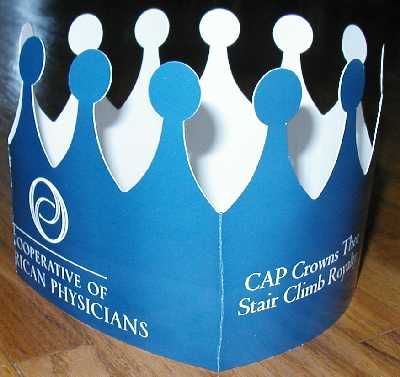
"CAP [Cooperative of American Physicians] Crowns Thee Stair Climb Royalty"
Until this occasion, I didn't know YMCA stood for Young Men's Christian Association (a.k.a. "The Y"). I had always assumed the C meant "community". I wasn't the only one; Google returns over 2,000 examples including this one for a 2012 Christian political candidate (expand his Additional Information section where he says he enjoyed working out at the local Young Men's Community Association & playing basketball).
In 1844 a 22-year-old man in London (of all places; I had thought it was strictly American) named George Williams formed it as "a refuge of Bible study and prayer for young men seeking escape from the hazards of life on the streets." The first American branch utilized Boston's famous Old South Church in 1851. Cool!
G.M. Grena
But when I began working at another company in an 8-story high-rise last year, I resumed this pastime & reached a point where I sought new challenges such as doing multiple laps, not using my arms, using only my arms, etc. I did my fastest 7-flight sprint in 40 seconds (note that an uninterrupted elevator ride takes about 20 seconds). Then I found out that each year a contest is held at the tallest skyscraper in downtown L.A., the 74-story US Bank Tower (originally referred to as the Library Tower), which is the 10th tallest one in America. Now that's what I call a challenge!
The downtown YMCA uses the event as a fundraiser since the building's staircase is normally off-limits for security reasons (I suppose). To help participants prepare, they arrange for training sessions at other high-rises nearby. In August they were held at the 777 Tower, which is 52 stories, but we were only allowed to climb 50 (again, presumably for some sort of security reason). My best time for all 49 flights was 9:30.
In September we switched to the 54-story Wells Fargo Tower, & I was so pleased with my progress that I compiled a video using still photos & my audio recording, & posted it on YouTube this weekend to commemorate my accomplishment of 49 flights in 8:42, all 53 in 9:43. I'm deliberately not linking to it here because the sound of my heavy breathing & gasping for air is not something I want to share with casual readers, but it's not hard to find.
I didn't do as well as I had hoped at "the big one" last Friday:
- #19 of 149 men in my age range (50-59) who finished
- #182 out of 1,466 men who finished
- #209 out of over 3,400 people who were registered to participate
(Note that more than 600 people quit or never began; there were 3 ambulances parked at the entrance.)
For many weeks I've been wondering how I'd do, & although I'm disappointed by my performance, at least now I have a realistic benchmark for next year. The highpoint of the day was getting to say a quick prayer to God from that highest point in The Angels city, looking down on so many landmarks. Building the Babylon tower wasn't bad; building it to exalt people over God was.
Each participant received a bag full of promotional items (nutrition bars, T-shirt, water bottle, pen, keychain, etc.), & I got a big kick out of this cardboard crown:

"CAP [Cooperative of American Physicians] Crowns Thee Stair Climb Royalty"
Until this occasion, I didn't know YMCA stood for Young Men's Christian Association (a.k.a. "The Y"). I had always assumed the C meant "community". I wasn't the only one; Google returns over 2,000 examples including this one for a 2012 Christian political candidate (expand his Additional Information section where he says he enjoyed working out at the local Young Men's Community Association & playing basketball).
In 1844 a 22-year-old man in London (of all places; I had thought it was strictly American) named George Williams formed it as "a refuge of Bible study and prayer for young men seeking escape from the hazards of life on the streets." The first American branch utilized Boston's famous Old South Church in 1851. Cool!
G.M. Grena
Saturday, August 11, 2012
Comment-Collapse Trauma from BibleInterp
Near the end of last month, LMLK VIP Prof. Yosef Garfinkel published an article (Data, Paradigms and Paradigm-Collapse Trauma: from Biblical Archaeology to Brutal Biblical Archaeology) on The Bible and Interpretation website.
Niels Peter Lemche posted a 6-paragraph comment (BibleInterp Comments [BIC] #2 & #3) against Garfinkel that I promptly challenged on 2 points (BIC #4).
Simultaneously, Philip Davies joined the discussion against Garfinkel (BIC #5).
Dr. Lemche accused me of proceeding with "stupid mantras", suggesting I read an unspecified "thousands of pages" by him plus the [complete?] works of 5 other scholars & their critics (BIC #6). I must've asked a really complicated question, no? Usually when somebody says something genuinely stupid to me, I give them a pithy, rational reply they can quickly digest, rather than recommending they build a spaceship & travel to outer space in search of intelligent life.
In my 2nd comment (BIC #7), I reiterated my challenge to NPL with additional specificity, then challenged Dr. Davies regarding his interpretation of the Tel Dan Stela.
This really frustrated NPL, because he's used to moderating other forums where he can simply ban participants who bother him. In his 3rd comment (BIC #8) he lamented the existence of a forum where challenges to "the establishment" could reside. What a terrible world we live in! True to the creed of great educators throughout history, he informed me that "the professionals owe [me] no explanation of anything." Completely unaware of the (negatively) controversial Lipschits/Sergi/Koch peer-review failure by the editors of Tel Aviv, he laughably declared I'd "never join a peer review committee".
After presenting the introduction to an obscure 1963 booklet that in no way supported his earlier statement I had challenged, he boasted of seeing "no further reason to continue this debate", falsely accused me of attacking Dr. Davies for being a "non-believer", & again lamented that I had not yet been "banned" over this.
Kudos to Uri Hurowitz for posting his observation that NPL failed to defend his positions (BIC #10).
Undoubtedly driving under the influence of NPL's desire, the BI moderator edited my 3rd & final comment (BIC #11), which contained a sarcastic response to NPL, & a response to someone named Martin who had written about the law of conservation of matter & a crucial experiment. Here's my summary that he deleted:
The deletion of this point proves that it really touches a nerve at BI, because despite their name (Bible AND Interpretation), they generally don't allow anything but conventional/mainstream interpretations of the Bible on their website. That's why I resorted to publishing my rebuttals to Cargill & Isbell on my own site (they also rejected my rebuttal to Vaughn/Pillers Dobler, but for reasons unrelated to Biblical interpretation).
Fine. I have no complaint against the BI editors for limiting discussions to views they believe are valid; I'm content with presenting my positions here for the record. It's unfortunate for BI readers, because they're misled by what appears to be a lack of reply from me. For example, Dr. Davies posted another message to me (BIC #12), & here's my entire reply they rejected:
When queried, the moderator said he rejected my remarks because he believed Davies would've jumped on me for using Omri when the point made by Davies concerned 6th-century Judah. He obviously couldn't comprehend my argument, & that's a poor reason to reject it.
Again, my original point was that Davies isn't applying his same skeptical objectivity consistently (Special Pleading). If you don't want to believe the HoD on the Dan Stela refers to a Judean king in a small surviving portion of a stela discussing kings, fine; don't expect me to believe that the laws of nature were randomly suspended to accommodate your belief that everything came from nothing, order came from disorder, & life from non-life.
Martin made a subsequent point (BIC #13) that "we should attend to the difference from things that can be scientifically tested and things that cannot."
Hidden within his statement is the false claim that the existence of God, or the veracity of God's revelation to us, cannot be tested or known (as science, literally knowledge). He's presupposing that God would have to be tested the same way we test material objects. Obviously it's invalid to expect to be able to test all things according to a single methodology.
For example, we can test the transition of solid ice to liquid water by applying heat; yet we would not test the aerodynamics of a paper airplane by applying heat. More ludicrous to emphasize my point, we would never test whether a person cried real tears by applying heat to their face!
We would not test the validity of a (non-physical) mathematical equation via (physical) substances. If 1+2=3 & 3=4-1, you don't have to apply heat to your computer screen to test my (obviously false) claim that 1+2 doesn't equal 4-1.
We can indeed test "whether God will wipe away all our tears" (as Martin posited) because we can trace that claim to a reliable source Who would know (Isaiah 25:8; Revelation 7:17; 21:4), & we could base our confidence in it the same we act with confidence based on other reliable sources (unless we're guilty of Special Pleading like Dr. Davies).
This leads into Martin's subsequent question, "What would show each of the different views to be mistaken?" My answer: We can show that the views espoused by Lemche & Davies rely upon logical fallacies, whereas mine maintains a rational consistency. That's common among scientists; we uphold theories & ideas until they're shown to be wrong.
We can easily show that non-Christian religions are wrong; & not only am I unaware of any similar test that has falsified the Bible, every test that we can apply to the Bible confirms its reliability (e.g., its transmission over centuries, events such as the global flood & the Hezekiah/Sennacherib confrontation, seals of named individuals, places bearing synchronized strata, intrinsically honest testimonies).
And thanks to Jose Castro for correcting Dr. Lemche again on whether Hezekiah was a king reigning over a kingdom named Judah, rather than merely a guy living in a place named Judah.
Proving Minimalists to be wrong is like catching fish in a barrel (that they, themselves swam into voluntarily, which is sad).
G.M. Grena
Niels Peter Lemche posted a 6-paragraph comment (BibleInterp Comments [BIC] #2 & #3) against Garfinkel that I promptly challenged on 2 points (BIC #4).
Simultaneously, Philip Davies joined the discussion against Garfinkel (BIC #5).
Dr. Lemche accused me of proceeding with "stupid mantras", suggesting I read an unspecified "thousands of pages" by him plus the [complete?] works of 5 other scholars & their critics (BIC #6). I must've asked a really complicated question, no? Usually when somebody says something genuinely stupid to me, I give them a pithy, rational reply they can quickly digest, rather than recommending they build a spaceship & travel to outer space in search of intelligent life.
In my 2nd comment (BIC #7), I reiterated my challenge to NPL with additional specificity, then challenged Dr. Davies regarding his interpretation of the Tel Dan Stela.
This really frustrated NPL, because he's used to moderating other forums where he can simply ban participants who bother him. In his 3rd comment (BIC #8) he lamented the existence of a forum where challenges to "the establishment" could reside. What a terrible world we live in! True to the creed of great educators throughout history, he informed me that "the professionals owe [me] no explanation of anything." Completely unaware of the (negatively) controversial Lipschits/Sergi/Koch peer-review failure by the editors of Tel Aviv, he laughably declared I'd "never join a peer review committee".
After presenting the introduction to an obscure 1963 booklet that in no way supported his earlier statement I had challenged, he boasted of seeing "no further reason to continue this debate", falsely accused me of attacking Dr. Davies for being a "non-believer", & again lamented that I had not yet been "banned" over this.
Kudos to Uri Hurowitz for posting his observation that NPL failed to defend his positions (BIC #10).
Undoubtedly driving under the influence of NPL's desire, the BI moderator edited my 3rd & final comment (BIC #11), which contained a sarcastic response to NPL, & a response to someone named Martin who had written about the law of conservation of matter & a crucial experiment. Here's my summary that he deleted:
"So before Philip davies (or Dr. Lemche) can present any cogent argument about the Bible, they first need a foundation to account for their ideas, hypotheses, theories; but they can't, so when their ideas are analyzed in their entirety, they're found relying on fallacies (& should be abandoned in lieu of a rational one). This is the 'crucial experiment' that Minimalism fails."
The deletion of this point proves that it really touches a nerve at BI, because despite their name (Bible AND Interpretation), they generally don't allow anything but conventional/mainstream interpretations of the Bible on their website. That's why I resorted to publishing my rebuttals to Cargill & Isbell on my own site (they also rejected my rebuttal to Vaughn/Pillers Dobler, but for reasons unrelated to Biblical interpretation).
Fine. I have no complaint against the BI editors for limiting discussions to views they believe are valid; I'm content with presenting my positions here for the record. It's unfortunate for BI readers, because they're misled by what appears to be a lack of reply from me. For example, Dr. Davies posted another message to me (BIC #12), & here's my entire reply they rejected:
"Dear philip davies, thank you for your response. No, I do not know any language other than English in depth. Are you saying you believe that Omri never reigned as a king, & that Assyrian inscriptions mentioning 'House of Omri' could not possibly be referring to an Israelite king when they conquered Samaria, that they were simply referring to an ungoverned land named BYT OMRY by its inhabitants for reasons we cannot possibly know?
We don't have the full word preceding 'BYT DVD' on the Dan Stela, but we do have a clear Kaf, & with my aforementioned context of 4 other instances of 'MLK' in this small surviving section of the overall stela, that's an impressive coincidence (1 out of 22); far more impressive than the likelihood of inanimate matter randomly acquiring animation (none out of zillions of scientific experiments). Just sayin'...
As for the formula you mentioned, in 2Samuel 2 we have 'DVD LMLK OL BYT YEUDE' (David to reign over [the] house [of] Judah), so again it wouldn't be wacko for one of his Judean descendants to be referred to as MLK BYT DVD, especially with the 'house of Saul', 'house of Jeroboam', & the northern kingdom's attested equivalents.
Oh, & for the record, we do have 'MLK BYT AL' in Joshua 12:16. And yes, I know it's a place, not a dynasty, but I was able to prove you wrong on that point despite not knowing classical Hebrew & Akkadian. Pretty impressive, no?
P.S. A belated 'thank you' to Uri Hurwitz for the point about Ben Gurion's Bible group; I was not aware of that."
When queried, the moderator said he rejected my remarks because he believed Davies would've jumped on me for using Omri when the point made by Davies concerned 6th-century Judah. He obviously couldn't comprehend my argument, & that's a poor reason to reject it.
Again, my original point was that Davies isn't applying his same skeptical objectivity consistently (Special Pleading). If you don't want to believe the HoD on the Dan Stela refers to a Judean king in a small surviving portion of a stela discussing kings, fine; don't expect me to believe that the laws of nature were randomly suspended to accommodate your belief that everything came from nothing, order came from disorder, & life from non-life.
Martin made a subsequent point (BIC #13) that "we should attend to the difference from things that can be scientifically tested and things that cannot."
Hidden within his statement is the false claim that the existence of God, or the veracity of God's revelation to us, cannot be tested or known (as science, literally knowledge). He's presupposing that God would have to be tested the same way we test material objects. Obviously it's invalid to expect to be able to test all things according to a single methodology.
For example, we can test the transition of solid ice to liquid water by applying heat; yet we would not test the aerodynamics of a paper airplane by applying heat. More ludicrous to emphasize my point, we would never test whether a person cried real tears by applying heat to their face!
We would not test the validity of a (non-physical) mathematical equation via (physical) substances. If 1+2=3 & 3=4-1, you don't have to apply heat to your computer screen to test my (obviously false) claim that 1+2 doesn't equal 4-1.
We can indeed test "whether God will wipe away all our tears" (as Martin posited) because we can trace that claim to a reliable source Who would know (Isaiah 25:8; Revelation 7:17; 21:4), & we could base our confidence in it the same we act with confidence based on other reliable sources (unless we're guilty of Special Pleading like Dr. Davies).
This leads into Martin's subsequent question, "What would show each of the different views to be mistaken?" My answer: We can show that the views espoused by Lemche & Davies rely upon logical fallacies, whereas mine maintains a rational consistency. That's common among scientists; we uphold theories & ideas until they're shown to be wrong.
We can easily show that non-Christian religions are wrong; & not only am I unaware of any similar test that has falsified the Bible, every test that we can apply to the Bible confirms its reliability (e.g., its transmission over centuries, events such as the global flood & the Hezekiah/Sennacherib confrontation, seals of named individuals, places bearing synchronized strata, intrinsically honest testimonies).
And thanks to Jose Castro for correcting Dr. Lemche again on whether Hezekiah was a king reigning over a kingdom named Judah, rather than merely a guy living in a place named Judah.
Proving Minimalists to be wrong is like catching fish in a barrel (that they, themselves swam into voluntarily, which is sad).
G.M. Grena
Sunday, August 05, 2012
Cargill Syndrome Infects Tel Aviv Scholar
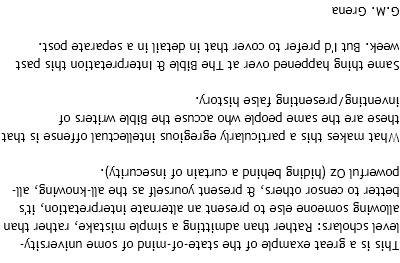
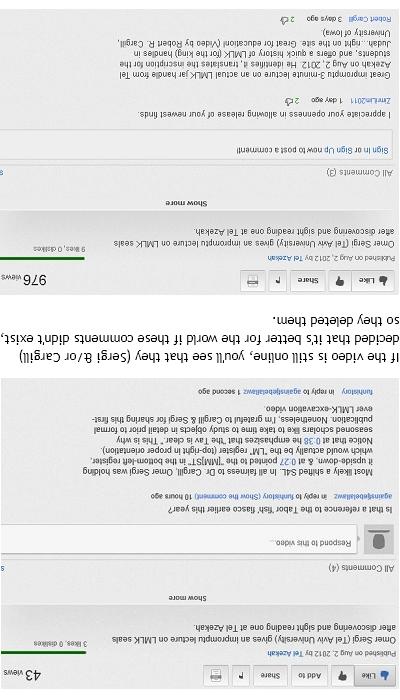
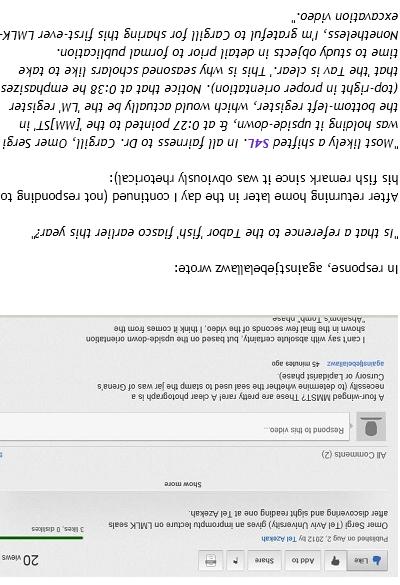
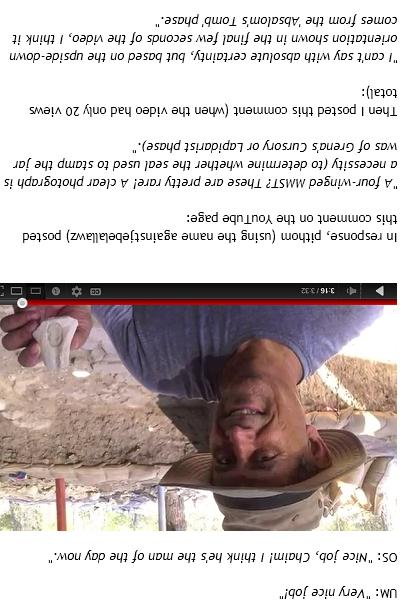
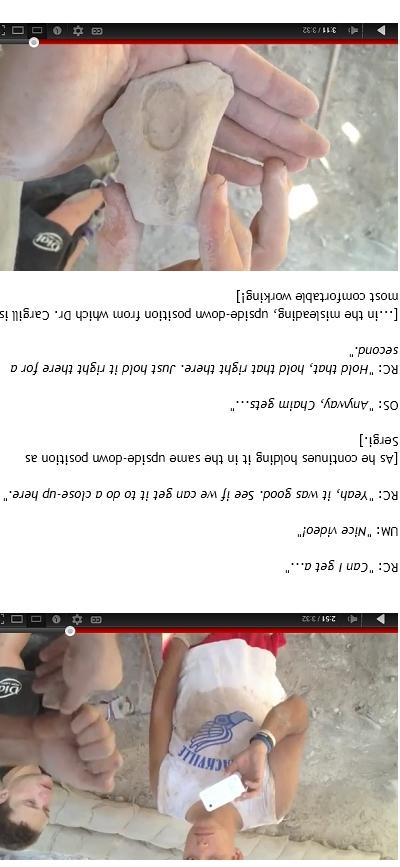
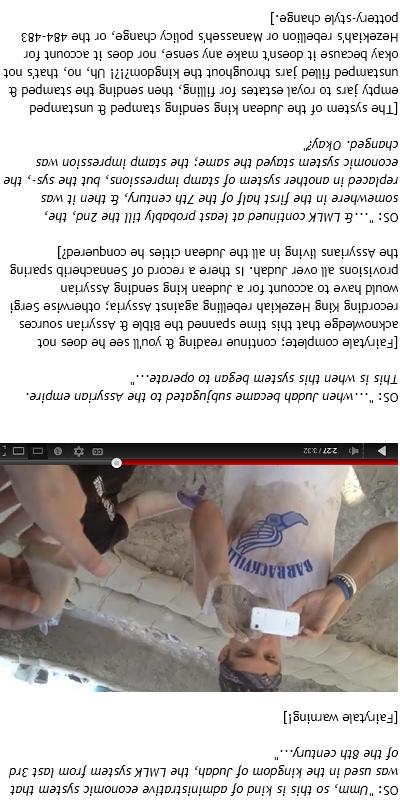
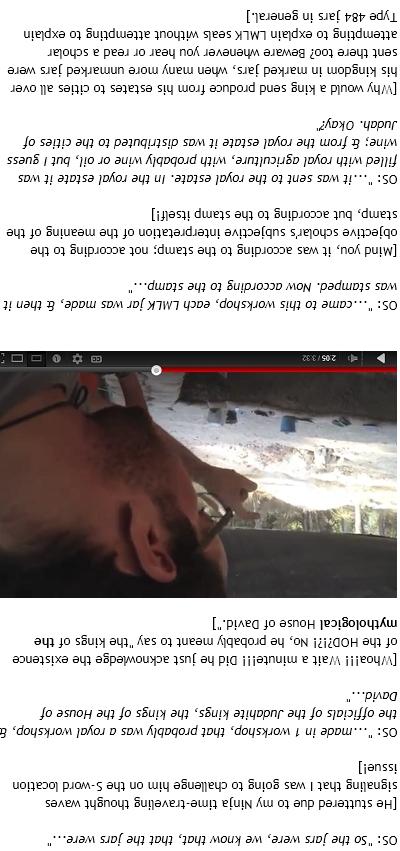
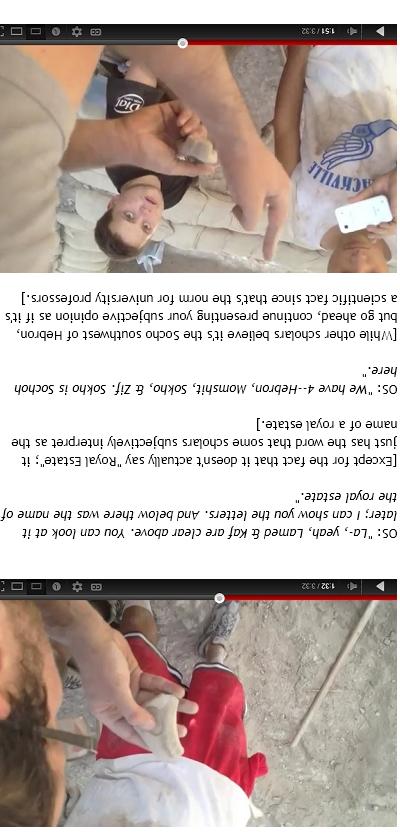
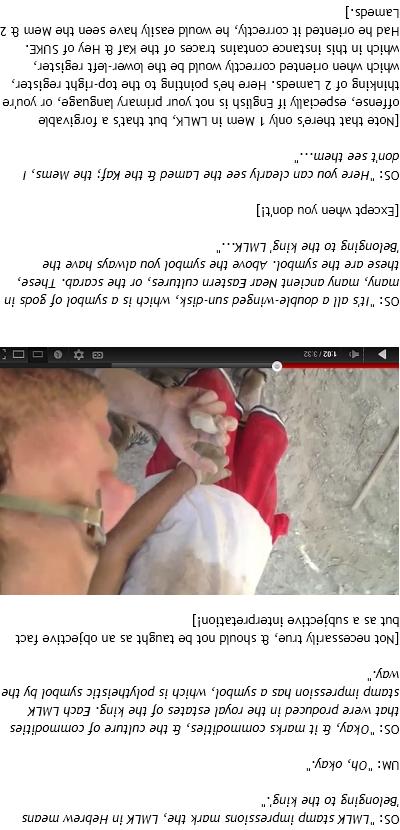
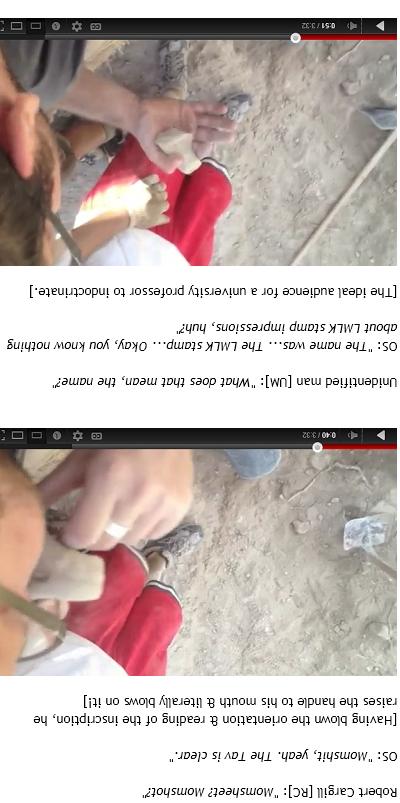
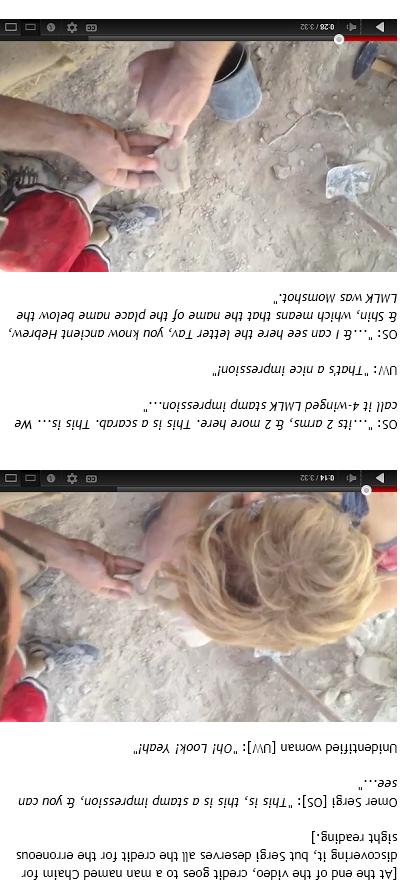
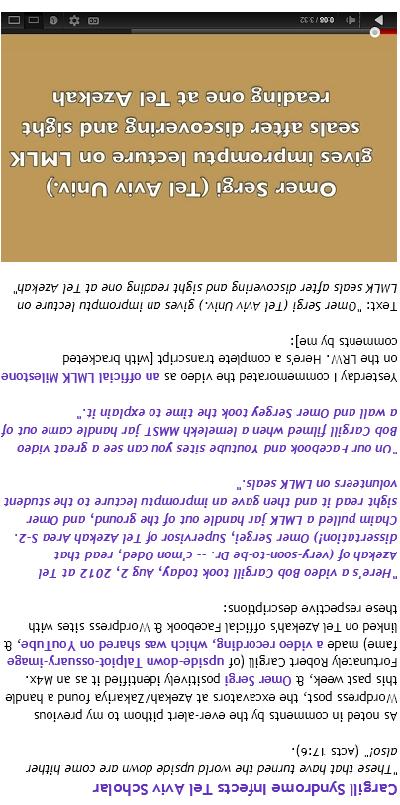
"These that have turned the world upside down are come hither also!" (Acts 17:6).
As noted in comments by the ever-alert pithom to my previous Wordpress post, the excavators at Azekah/Zakariya found a handle this past week, & Omer Sergi positively identified it as an M4x. Fortunately Robert Cargill (of upside-down Talpiot-ossuary-image fame) made a video recording, which was shared on YouTube, & linked on Tel Azekah's official Facebook & Wordpress sites with these respective descriptions:
"Here's a video Bob Cargill took today, Aug 2, 2012 at Tel Azekah of (very-soon-to-be Dr. -- c'mon Oded, read that dissertation!) Omer Sergei, Supervisor of Tel Azekah Area S-2. Chaim pulled a LMLK jar handle out of the ground, and Omer sight read it and then gave an impromptu lecture to the student volunteers on LMLK seals."
"On our Facebook and Youtube sites you can see a great video Bob Cargill filmed when a lemelekh MMST jar handle came out of a wall and Omer Sergey took the time to explain it."
Yesterday I commemorated the video as an official LMLK Milestone on the LRW. Here's a complete transcript [with bracketed comments by me]:
Text: "Omer Sergi (Tel Aviv Univ.) gives an impromptu lecture on LMLK seals after discovering and sight reading one at Tel Azekah"
[At the end of the video, credit goes to a man named Chaim for discovering it, but Sergi deserves all the credit for the erroneous sight reading.]
Omer Sergi [OS]: "This is, this is a stamp impression, & you can see..."
Unidentified woman [UW]: "Oh! Look! Yeah!"
OS: "...its 2 arms, & 2 more here. This is a scarab. This is... We call it 4-winged LMLK stamp impression..."
UW: "That's a nice impression!"
OS: "...& I can see here the letter Tav, you know ancient Hebrew, & Shin, which means that the name of the place name below the LMLK was Momshot."
Robert Cargill [RC]: "Momsheet? Momshot?"
OS: "Momshit, yeah. The Tav is clear."
[Having blown the orientation & reading of the inscription, he raises the handle to his mouth & literally blows on it!]
Unidentified man [UM]: "What does that mean, the name?"
OS: "The name was... The LMLK stamp... Okay, you know nothing about LMLK stamp impressions, huh?"
[The ideal audience for a university professor to indoctrinate.]
OS: "LMLK stamp impressions mark the, LMLK in Hebrew means 'Belonging to the king'."
UM: "Oh, okay."
OS: "Okay, & it marks commodities, & the culture of commodities that were produced in the royal estates of the king. Each LMLK stamp impression has a symbol, which is polytheistic symbol by the way."
[Not necessarily true, & should not be taught as an objective fact but as a subjective interpretation!]
OS: "It's all a double-winged sun-disk, which is a symbol of gods in many, many ancient Near Eastern cultures, or the scarab. These, these are the symbol. Above the symbol you always have the 'Belonging to the king' LMLK..."
[Except when you don't!]
OS: "Here you can clearly see the Lamed & the Kaf; the Mems, I don't see them..."
[Note that there's only 1 Mem in LMLK, but that's a forgivable offense, especially if English is not your primary language, or you're thinking of 2 Lameds. Here he's pointing to the top-right register, which when oriented correctly would be the lower-left register, which in this instance contains traces of the Kaf & Hey of SUKE. Had he oriented it correctly, he would easily have seen the Mem & 2 Lameds.]
OS: "La-, yeah, Lamed & Kaf are clear above. You can look at it later; I can show you the letters. And below there was the name of the royal estate."
[Except for the fact that it doesn't actually say "Royal Estate"; it just has the word that some scholars subjectively interpret as the name of a royal estate.]
OS: "We have 4--Hebron, Momshit, Sokho, & Zif. Sokho is Sochoh here."
[While other scholars believe it's the Socho southwest of Hebron, but go ahead, continue presenting your subjective opinion as if it's a scientific fact since that's the norm for university professors.]
OS: "So the jars were, we know that, that the jars were..."
[He stuttered due to my Ninja time-traveling thought waves signaling that I was going to challenge him on the S-word location issue!]
OS: "...made in 1 workshop, that probably was a royal workshop, & the officials of the Judahite kings, the kings of the House of David..."
[Whoa!!! Wait a minute!!! Did he just acknowledge the existence of the HOD?!?! No, he probably meant to say "the kings of the mythological House of David."]
OS: "...came to this workshop, each LMLK jar was made, & then it was stamped. Now according to the stamp..."
[Mind you, it was according to the stamp; not according to the objective scholar's subjective interpretation of the meaning of the stamp, but according to the stamp itself!]
OS: "...it was sent to the royal estate. In the royal estate it was filled with royal agriculture, with probably wine or oil, but I guess wine; & from the royal estate it was distributed to the cities of Judah. Okay?"
[Why would a king send produce from his estates to cities all over his kingdom in marked jars, when many more unmarked jars were sent there too? Beware whenever you hear or read a scholar attempting to explain LMLK seals without attempting to explain Type 484 jars in general.]
OS: "Umm, so this is kind of administrative economic system that was used in the kingdom of Judah, the LMLK system from last 3rd of the 8th century..."
[Fairytale warning!]
OS: "...when Judah became subjugated to the Assyrian empire. This is when this system began to operate..."
[Fairytale complete; continue reading & you'll see he does not acknowledge that this time spanned the Bible & Assyrian sources recording King Hezekiah rebelling against Assyria; otherwise Sergi would have to account for a Judean king sending Assyrian provisions all over Judah. Is there a record of Sennacherib sparing the Assyrians living in all the Judean cities he conquered?]
OS: "...& LMLK continued at least probably till the 2nd, the, somewhere in the first half of the 7th century, & then it was replaced in another system of stamp impressions, but the sys-, the economic system stayed the same; the stamp impression was changed. Okay?"
[The system of the Judean king sending stamped & unstamped empty jars to royal estates for filling, then sending the stamped & unstamped filled jars throughout the kingdom?!?! Uh, no, that's not okay because it doesn't make any sense, nor does it account for Hezekiah's rebellion or Manasseh's policy change, or the 484-483 pottery-style change.]
RC: "Can I get a..."
UM: "Nice video!"
RC: "Yeah, it was good. See if we can get it to do a close-up here."
[As he continues holding it in the same upside-down position as Sergi.]
OS: "Anyway, Chaim gets..."
RC: "Hold that, hold that right there. Just hold it right there for a second."
[...in the misleading, upside-down position from which Dr. Cargill is most comfortable working!]
UM: "Very nice job!"
OS: "Nice job, Chaim! I think he's the man of the day now."
In response, pithom (using the name againstjebelallawz) posted this comment on the YouTube page:
"A four-winged MMST? These are pretty rare! A clear photograph is a necessity (to determine whether the seal used to stamp the jar was of Grena's Cursory or Lapidarist phase)."
Then I posted this comment (when the video had only 20 views total):
"I can't say with absolute certainty, but based on the upside-down orientation shown in the final few seconds of the video, I think it comes from the 'Absalom's Tomb' phase."
In response, againstjebelallawz wrote:
"Is that a reference to the Tabor 'fish' fiasco earlier this year?"
After returning home later in the day I continued (not responding to his fish remark since it was obviously rhetorical):
"Most likely a shifted S4L. In all fairness to Dr. Cargill, Omer Sergi was holding it upside-down, & at 0:27 pointed to the '[MM]ST' in the bottom-left register, which would actually be the 'LM' register (top-right in proper orientation). Notice that at 0:38 he emphasizes that 'the Tav is clear.' This is why seasoned scholars like to take time to study objects in detail prior to formal publication. Nonetheless, I'm grateful to Cargill for sharing this first-ever LMLK-excavation video."
If the video is still online, you'll see that they (Sergi &/or Cargill) decided that it's better for the world if these comments didn't exist, so they deleted them.
This is a great example of the state-of-mind of some university-level scholars: Rather than admitting a simple mistake, rather than allowing someone else to present an alternate interpretation, it's better to censor others, & present yourself as the all-knowing, all-powerful Oz (hiding behind a curtain of insecurity).
What makes this a particularly egregious intellectual offense is that these are the same people who accuse the Bible writers of inventing/presenting false history.
Same thing happened over at The Bible & Interpretation this past week. But I'd prefer to cover that in detail in a separate post.
G.M. Grena
Monday, July 30, 2012
RLT LMLK
Just a quick note for posterity that today (July 30th, 2012), I executed a revocable living trust to transfer my property (including a bunch of broken jar handles) after my departure. And no, I don't expect to leave soon.
"Make me like a child of clay."
G.M. Grena
"Make me like a child of clay."
G.M. Grena
Sunday, July 22, 2012
Overlaid-Pixel-Color Sorting
Four score & 7 years ago, I learned about Polynomial Texture Mapping (PTM) at the West Semitic Research Center (as a guest of Dr. Bruce Zuckerman at the request of Dr. Gabriel Barkay who was in town at the time; it was an incredible privilege). After snapping multiple photos of an artifact using a variety of lighting angles, a Java-based program allows you to manipulate a single image as if you were shining your own light on it. The result is interesting, but the process is complicated, & to that end, discouraging.
I won't rehearse all the details here (see my 3-part blog entries from that time), but ever since then, the back of my mind has been wondering if there's a way to automatically generate a single optimum image of a seal impression. I envisioned a photo where the seal's most important/distinguishing features were highlighted with a bright color & outlined with a dark one (i.e., a wraparound shadow, something prohibited by the laws of physics).
In my previous entry, "Not a Handle Photo", I showed such an artificial image using Michael Welch's #195 handle. Israel Finkelstein (my newfound friend of a friend) even played an indirect role in inspiring this innovative endeavor, as I'll explain.
In the final edit of my 3rd article (recently) published on The Bible & Interpretation website, I cited a new article co-authored by Arie Shaus, Israel Finkelstein, & Eli Piasetzky: "Bypassing the Eye of the Beholder: Automated Ostraca Facsimile Evaluation" in MAARAV: A Journal for the Study of the Northwest Semitic Languages and Literatures 17.1 ("2010"; I put the year in quotes because it was actually published this year, but the Maarav publication schedule is lost in a time warp).
In this article (among other things), Shaus et al. show an alignment registration between 2 Arad ostraca photos & line-drawings of their respective inscriptions made by multiple scholars. Using image-editing software, they were able to stack each drawing atop the image, & numerically qualify the drawing's accuracy based on the visible clay surface or exposed ink.
My brain eventually made the connection between being able to analyze ostracon pixels & being able to analyze the colors of LMLK handle photos taken with alternate lighting angles (i.e., PTM). I spent the first half of our July 4th day off (from regular work) to see if I could construct a program that would do this, & obviously I was successful.
During the past week, "Pithom" posted a comment to my previous blog entry (WordPress version) speculating that I processed my photos using the Photoshop program, which is an industry-standard tool, "(or a similar software)". I used a very early version of Photoshop for a technical-writing job back in 1999, but I haven't touched it since.
I was curious if the current version (with more than a decade of technological advances) could do what I did, so I posted an inquiry on their website. One of their employees responded promptly explaining how it could be done, but the answer (as I expected) was that it doesn't do it. The Extended version sells for $999, but apparently I would also need a customized plug-in (cost unknown). This didn't surprise me as optimum seal-impression photos are not as u$eful in the real world as optimized celebrity photos.
Here is a composite image of 9 cropped & reduced photos of Mike's #195 (I felt it would be best to make this small version to fit in the standard blog width, but you can click on it to pop open a larger version for reference viewing):
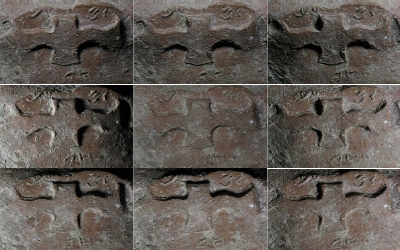
I arranged them in a 3x3 matrix according to the placement of my light source, which should be obvious from the shadows.
My program stacks/overlays the original photos, then allows me to generate a new image utilizing any of 6 general methods, some of which allow sub-methods. The first/main routine simply sorts the values for each pixel numerically, & allows me to choose the level. Here are all 9 from darkest to lightest:
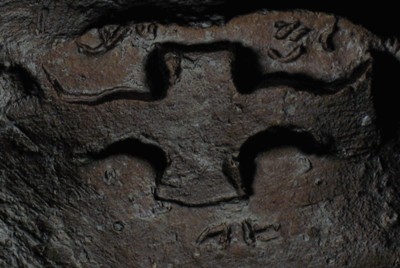
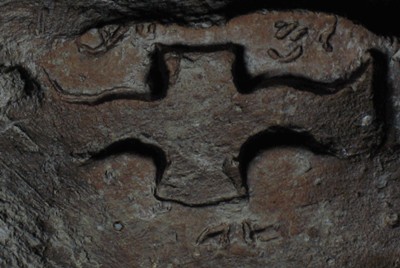
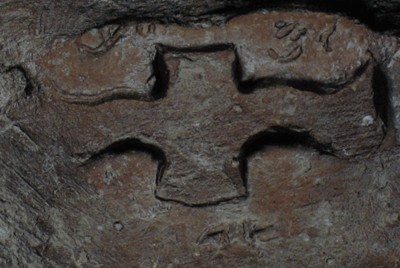
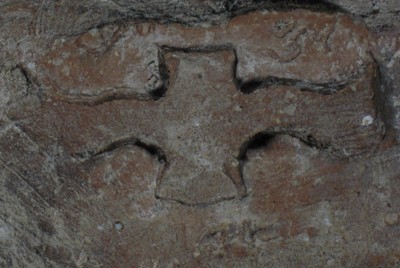
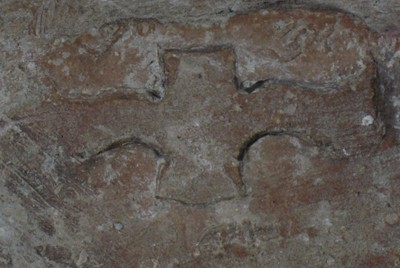
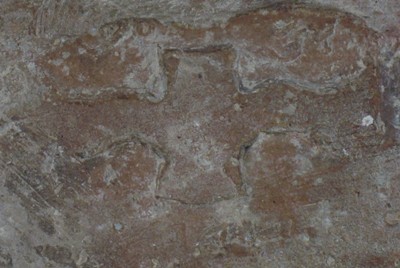
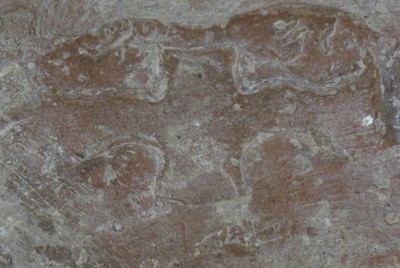
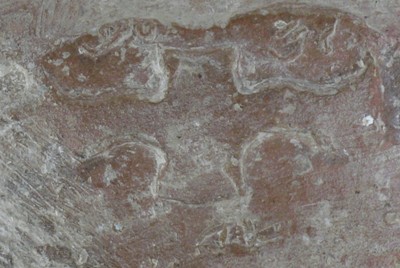
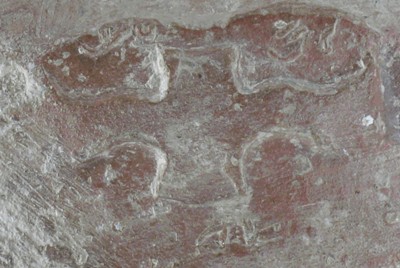
I want to emphasize that unlike the PTM software, which calculates what the programmer believes the object would look like if the light were illuminating the object & casting shadows from any particular angle; my OPCS s/w uses only real/actual pixel-color values from the original photos.
Notice that the Photoshop employee mentioned that the current version can do the extremes or middle, but not the in-betweens, & the one that seemed best for this particular handle (the one I posted last week in my teaser preview) was the next-to-darkest one. I suspected that would be the case when I began constructing the program since there would usually be a dark, shadow region for most of the pixels, but an optimal in-between level.
Despite the initial success with my original idea, my engineering curiosity led me to experiment with slightly more complicated methods of determining the optimum value for each pixel, just to be thorough. I'll show them here for amusement purposes. This first one simply takes an average value for the colors:
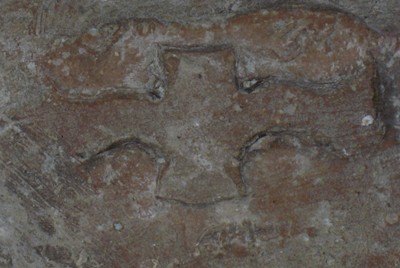
This one uses a standard deviation value (it didn't matter whether I calculated it as a full-population or representative-sample weight):
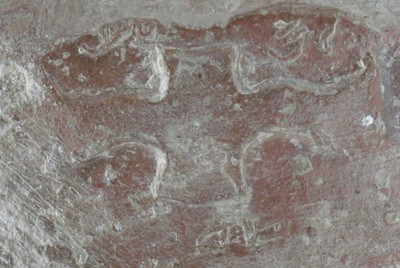
I named this routine "zig-zag" because I alternated between the brightest & darkest values for adjacent pixels:
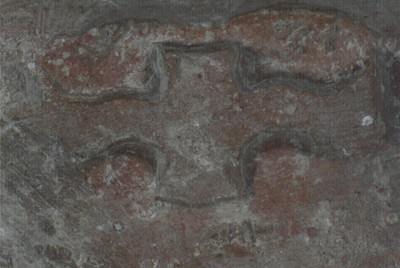
Notice the nice icon outline, but washed-out inscription; similar results with the next-to-brightest, next-to-darkest zig-zag:
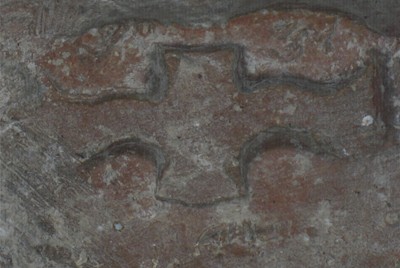
I called this one a "scroll" because I simply scrolled through the darkest-to-lightest values for contiguous pixels:
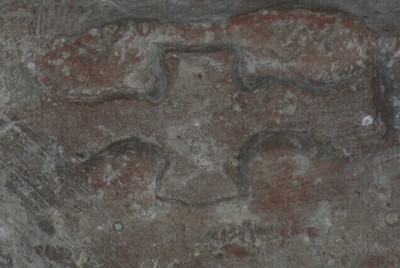
And a randomizer (randomly selecting any one of the overlaid pixel colors; the overall image didn't actually change much during subsequent iterations):
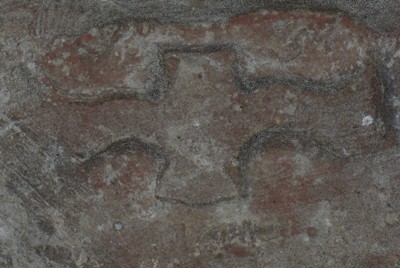
I simply don't have time to re-photograph all of my handles & process them, but suspect that a large quantity, though not a majority, would benefit from this process. Most of the existing photographs are already sufficient representatives, but it would be fun to see the OPCS versions.
I chose Welch #195 because it had a mostly full icon & top/bottom inscriptions, all over a mostly flat plane/surface. In his comments/guesses, "Pithom" linked to my December 2007 post, "LMLK Handle Documentation Process", which included my #66 H4C with the disappearing fingerprint ridges. What you can't discern from a 2-dimensional representation is that the "LM" inscription rests in a canyon caused by a seal-stabbing depression that was shadowed in most of the photos, so its low-level OPCS didn't turn out well, though the multiple impressions of the seal border turned out excellent:
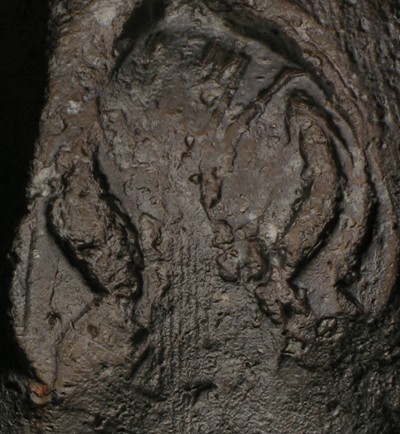
The best version of the inscription (showing each of the weird Mem strokes) came out in the brightest OPCS:
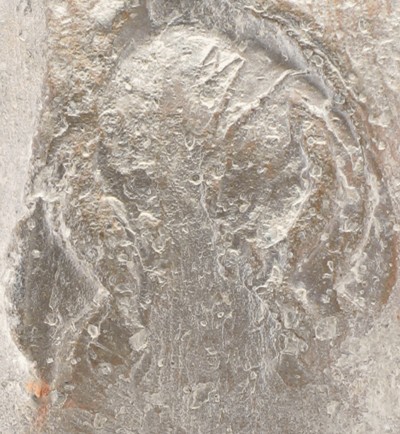
I also ran an experiment today on my Siloam Inscription replica, which represents an incision, or recessed feature, the opposite surface type from a seal impression. Here I hoped to show all the letters as blackened shadows (you can click this image to see a much bigger version):
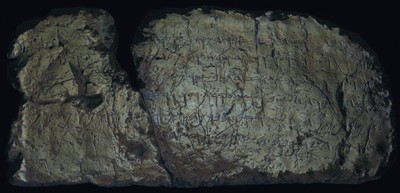
Of course the product of a replica can't be expected to match that of Sayce's from the original squeeze (especially with so many stray cracks & abrasions, which from an OPCS perspective are the things it's trying to highlight), but I feel a sense of accomplishment, & believe this tool will be a useful addition to future photography sessions.
G.M. Grena
I won't rehearse all the details here (see my 3-part blog entries from that time), but ever since then, the back of my mind has been wondering if there's a way to automatically generate a single optimum image of a seal impression. I envisioned a photo where the seal's most important/distinguishing features were highlighted with a bright color & outlined with a dark one (i.e., a wraparound shadow, something prohibited by the laws of physics).
In my previous entry, "Not a Handle Photo", I showed such an artificial image using Michael Welch's #195 handle. Israel Finkelstein (my newfound friend of a friend) even played an indirect role in inspiring this innovative endeavor, as I'll explain.
In the final edit of my 3rd article (recently) published on The Bible & Interpretation website, I cited a new article co-authored by Arie Shaus, Israel Finkelstein, & Eli Piasetzky: "Bypassing the Eye of the Beholder: Automated Ostraca Facsimile Evaluation" in MAARAV: A Journal for the Study of the Northwest Semitic Languages and Literatures 17.1 ("2010"; I put the year in quotes because it was actually published this year, but the Maarav publication schedule is lost in a time warp).
In this article (among other things), Shaus et al. show an alignment registration between 2 Arad ostraca photos & line-drawings of their respective inscriptions made by multiple scholars. Using image-editing software, they were able to stack each drawing atop the image, & numerically qualify the drawing's accuracy based on the visible clay surface or exposed ink.
My brain eventually made the connection between being able to analyze ostracon pixels & being able to analyze the colors of LMLK handle photos taken with alternate lighting angles (i.e., PTM). I spent the first half of our July 4th day off (from regular work) to see if I could construct a program that would do this, & obviously I was successful.
During the past week, "Pithom" posted a comment to my previous blog entry (WordPress version) speculating that I processed my photos using the Photoshop program, which is an industry-standard tool, "(or a similar software)". I used a very early version of Photoshop for a technical-writing job back in 1999, but I haven't touched it since.
I was curious if the current version (with more than a decade of technological advances) could do what I did, so I posted an inquiry on their website. One of their employees responded promptly explaining how it could be done, but the answer (as I expected) was that it doesn't do it. The Extended version sells for $999, but apparently I would also need a customized plug-in (cost unknown). This didn't surprise me as optimum seal-impression photos are not as u$eful in the real world as optimized celebrity photos.
Here is a composite image of 9 cropped & reduced photos of Mike's #195 (I felt it would be best to make this small version to fit in the standard blog width, but you can click on it to pop open a larger version for reference viewing):

I arranged them in a 3x3 matrix according to the placement of my light source, which should be obvious from the shadows.
My program stacks/overlays the original photos, then allows me to generate a new image utilizing any of 6 general methods, some of which allow sub-methods. The first/main routine simply sorts the values for each pixel numerically, & allows me to choose the level. Here are all 9 from darkest to lightest:









I want to emphasize that unlike the PTM software, which calculates what the programmer believes the object would look like if the light were illuminating the object & casting shadows from any particular angle; my OPCS s/w uses only real/actual pixel-color values from the original photos.
Notice that the Photoshop employee mentioned that the current version can do the extremes or middle, but not the in-betweens, & the one that seemed best for this particular handle (the one I posted last week in my teaser preview) was the next-to-darkest one. I suspected that would be the case when I began constructing the program since there would usually be a dark, shadow region for most of the pixels, but an optimal in-between level.
Despite the initial success with my original idea, my engineering curiosity led me to experiment with slightly more complicated methods of determining the optimum value for each pixel, just to be thorough. I'll show them here for amusement purposes. This first one simply takes an average value for the colors:

This one uses a standard deviation value (it didn't matter whether I calculated it as a full-population or representative-sample weight):

I named this routine "zig-zag" because I alternated between the brightest & darkest values for adjacent pixels:

Notice the nice icon outline, but washed-out inscription; similar results with the next-to-brightest, next-to-darkest zig-zag:

I called this one a "scroll" because I simply scrolled through the darkest-to-lightest values for contiguous pixels:

And a randomizer (randomly selecting any one of the overlaid pixel colors; the overall image didn't actually change much during subsequent iterations):

I simply don't have time to re-photograph all of my handles & process them, but suspect that a large quantity, though not a majority, would benefit from this process. Most of the existing photographs are already sufficient representatives, but it would be fun to see the OPCS versions.
I chose Welch #195 because it had a mostly full icon & top/bottom inscriptions, all over a mostly flat plane/surface. In his comments/guesses, "Pithom" linked to my December 2007 post, "LMLK Handle Documentation Process", which included my #66 H4C with the disappearing fingerprint ridges. What you can't discern from a 2-dimensional representation is that the "LM" inscription rests in a canyon caused by a seal-stabbing depression that was shadowed in most of the photos, so its low-level OPCS didn't turn out well, though the multiple impressions of the seal border turned out excellent:

The best version of the inscription (showing each of the weird Mem strokes) came out in the brightest OPCS:

I also ran an experiment today on my Siloam Inscription replica, which represents an incision, or recessed feature, the opposite surface type from a seal impression. Here I hoped to show all the letters as blackened shadows (you can click this image to see a much bigger version):

Of course the product of a replica can't be expected to match that of Sayce's from the original squeeze (especially with so many stray cracks & abrasions, which from an OPCS perspective are the things it's trying to highlight), but I feel a sense of accomplishment, & believe this tool will be a useful addition to future photography sessions.
G.M. Grena
Saturday, July 14, 2012
Not a Handle Photo
Time for another riddle, which I will unravel in my next entry. For now, all I want to do is tease readers by saying that what you see below is not a photo of Michael Welch's #195 handle (nor is it a photo of the #195 impression for those who want to get technical):
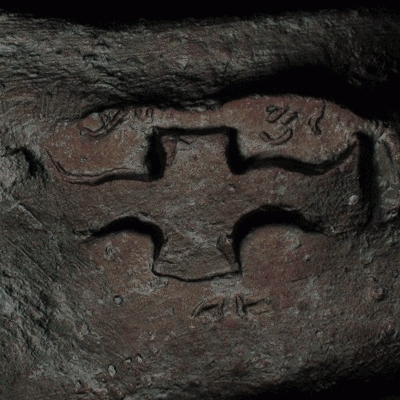
Anyone who has photographed or studied photographs of seal impressions will readily acknowledge that what I said is true.
And this is not my favorite group, Heritage Singers, singing the title track from my favorite Heritage Singers album:
G.M. Grena

Anyone who has photographed or studied photographs of seal impressions will readily acknowledge that what I said is true.
And this is not my favorite group, Heritage Singers, singing the title track from my favorite Heritage Singers album:
G.M. Grena
Sunday, July 08, 2012
LMLK in Me
Probably due to increased physical exercise, I experienced some unusual medical symptoms at the end of May, which prompted some exhaustive tests. I'm ambivalent towards learning that all the results were negative (no disease or internal injury found) because it would be comforting to know exactly what caused the symptoms.
This was the first time I underwent a CT (computed tomography) scan, & it was actually fun to review the images of my abdominal region. Here's a sample:
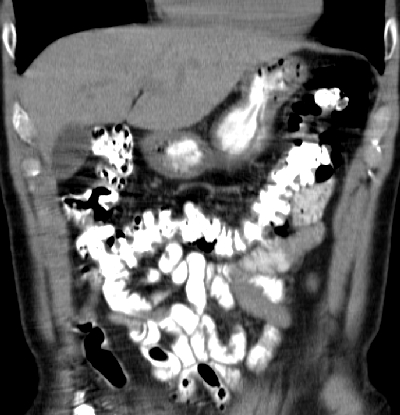
Now at least no one can legitimately accuse me of not having any guts!
After studying all 202 slices from 3 dimensions, I chose this particular one because I think it indicates what caused my ill symptoms.
In the modified version below, I highlighted the apparent problems ... the long stroke of my Mem was way too vertical, & my Kaf was completely out-of-line with the other 3 letters.
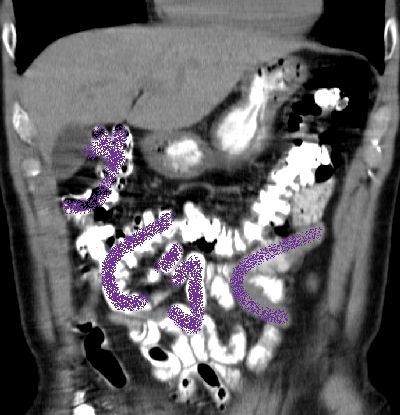
One of my favorite pop songs from the 70s came to mind (lyrics composed by Tobias "Bias" Boshell, slightly modified by me):
"Ain't got no trouble in my life
No foolish dream to make me cry
I'm never frightened or worried
I know I'll always get by
I heat up, I cool down
When something gets in my way I go round it
Don't let life get me down
Gonna take it the way that I found it
I've got [lamelech] in me
I've got [lamelech] in me
I've got [lamelech] in me
They say that life is a circle
But that ain't the way that I found it
Gonna move in a straight line
Keeping my feet firmly on the ground
I heat up, I cool down
I've got words in my head so I say them
Don't let life get me down
Catch a hold of my blues, gonna play them
I've got [lamelech] in me
I've got [lamelech] in me
I've got [lamelech] in me
Feel funky, feel good
Gonna tell you I'm in the neighborhood
Gonna fly like a bird on the wing
Hold onto your hat honey - sing, sing, sing, sing"
"I will sing to the LORD while I live: I will sing praise to my God while I have my being" (Psalms 104:33; 146:2).
G.M. Grena
This was the first time I underwent a CT (computed tomography) scan, & it was actually fun to review the images of my abdominal region. Here's a sample:

Now at least no one can legitimately accuse me of not having any guts!
After studying all 202 slices from 3 dimensions, I chose this particular one because I think it indicates what caused my ill symptoms.
In the modified version below, I highlighted the apparent problems ... the long stroke of my Mem was way too vertical, & my Kaf was completely out-of-line with the other 3 letters.

One of my favorite pop songs from the 70s came to mind (lyrics composed by Tobias "Bias" Boshell, slightly modified by me):
"Ain't got no trouble in my life
No foolish dream to make me cry
I'm never frightened or worried
I know I'll always get by
I heat up, I cool down
When something gets in my way I go round it
Don't let life get me down
Gonna take it the way that I found it
I've got [lamelech] in me
I've got [lamelech] in me
I've got [lamelech] in me
They say that life is a circle
But that ain't the way that I found it
Gonna move in a straight line
Keeping my feet firmly on the ground
I heat up, I cool down
I've got words in my head so I say them
Don't let life get me down
Catch a hold of my blues, gonna play them
I've got [lamelech] in me
I've got [lamelech] in me
I've got [lamelech] in me
Feel funky, feel good
Gonna tell you I'm in the neighborhood
Gonna fly like a bird on the wing
Hold onto your hat honey - sing, sing, sing, sing"
"I will sing to the LORD while I live: I will sing praise to my God while I have my being" (Psalms 104:33; 146:2).
G.M. Grena
Monday, June 25, 2012
Satan, Your KINGdom Must Come Down
Altogether only 4 simple lines in this American folksong that dates to at least the early 20th century:
Here are 2 excellent renditions. First a more melodic version by Robert Plant, vocalist for the 1970s supergroup, Led Zeppelin, followed by country/western superstar Willie Nelson with a haunting, somber version. The serious look on both of their faces speaks volumes!
G.M. Grena
"I'm gonna pray until they tear your kingdom down!
Gonna shout till they tear your kingdom down!
I heard the voice of Jesus say,
'Satan, your kingdom must come down'"
Here are 2 excellent renditions. First a more melodic version by Robert Plant, vocalist for the 1970s supergroup, Led Zeppelin, followed by country/western superstar Willie Nelson with a haunting, somber version. The serious look on both of their faces speaks volumes!
G.M. Grena
Saturday, June 16, 2012
1943 Guide to Lachish
At the end of last year I acquired a rare little booklet about Lachish published by an illegitimate, now-defunct organization. When I read it back in January, it led me to discover something that I'm sure will surprise many people interested in Biblical archeology.
I wrote a formal article about the subject back in April, & felt it would be of interest to readers of The Bible & Interpretation website. One of the scholars to whom I sent a review copy disagreed about a quotation of his in one of my footnotes, & it delayed the publication, which would've been in May, but now will probably be near the end of June, beginning of July.
I felt it would be fitting to publish this out-of-print booklet as a background to my 3rd B&I article, & to intrigue readers with 3 clues about the subject. The formatting below is basically as it appears in the 20-page booklet, though I'm not reproducing any of the 8 figures (which are photos & drawings used by the excavators in later publications).
Enjoy!
*******
GOVERNMENT OF PALESTINE
DEPARTMENT OF ANTIQUITIES
GUIDE TO LACHISH
TELL ED DUWEIR
by
G. Lankester Harding
Jerusalem, 1943
Price 30 mils
FOREWORD.
The Department of Antiquities is indebted for this Guide to Mr. G. Lankester Harding, now Chief Curator of Antiquities in Trans-Jordan, who participated for several years in the exploration of the site which he has kindly consented to describe.
Our knowledge of Tell ed Duweir and its history is almost entirely due to systematic excavations carried out by an expedition organized and directed by the late Mr. J. L. Starkey with funds provided by the late Sir Henry Wellcome and Sir Charles Marston.
The expedition started work in the winter of 1932 and continued year by year until 1938 when Mr. Starkey was murdered by bandits on the road just outside Hebron. Readers of this Guide will be able to appreciate the importance of the discoveries which had been made when the work, still at an early stage, was thus deplorably cut short. It is greatly to be hoped that the exploration of this promising site may yet be renewed.
The Department has to thank the Wellcome-Marston Archaeological Expedition for the photographs reproduced in Figs. 1, 2 (inset), 7 and 8.
R. W. Hamilton.
Director of Antiquities
LACHISH--TELL ED DUWEIR.
Tell ed Duweir, the "hill of the little monastery", stands in the foothills of the Judaean mountains, a few miles south-west of Beit Jibrin, and near the modern village of Qubeiba.
It is sufficiently elevated to command from its summit an extensive view across the plain as far as the sea. The mound itself is a magnificent and imposing example of an ancient city site, rising boldly up from a hollow in the hills, from which it is isolated on all sides except the south, where a narrow shoulder of rock connects it with the plateau (Fig. 1).
Fig. 1. Tell ed Duweir from the south-west
The identification of Tell ed Duweir with the Biblical city of Lachish is widely accepted and there is strong evidence to support it, but it must be mentioned that Tell el Hesy a few miles to the south-west is a rival claimant. The chief support for the Duweir-Lachish equation is found in the Lachish Letters, about which more will be said later, and the situation ascribed to Lachish in a list of biblical place names compiled by Eusebius, Bishop of Caesarea, in the 4th century, where it is said to be seven Roman miles from Beit Jibrin on the road to the south. Excavation has shown that a Roman road ran by the mound up the western valley, and the distance is almost exactly right.
It has not been established how many ruined cities are superimposed one on the other to make up the 60 feet of artificial deposit of the mound, as the only excavation which has gone through to bed-rock was a small trial trench on the north face. This revealed that the site was occupied to the full extent of its area from the Chalcolithic period, the age of transition from the Stone to the Bronze Age, about 3,500 B.C., down to about 400 B.C. Further, in the earliest period there was a suburb of some size on the ridge to the west, and excavation there showed that most of the dwellings were caves, which occur naturally in great numbers in the soft limestone. The remains of a few dolmens a little further west may also belong to this time.
In the period immediately following, the Early Bronze Age (3000-2000 B.C.), many of these cave-dwellings were re-used as tombs, and considerable quantities of pottery and sometimes personal ornaments were interred with the bodies. A cemetery of slightly later date, the end of the Early and beginning of the Middle Bronze Age (about 2000 B.C.), was found on the slopes to the north of the Tell, not far from the present village well. Here were single crouched burials in small graves, with a pot or two and occasionally a copper dagger or dart.
The present most characteristic feature of the mound, its steeply sloping sides, is due to the defensive works of the Hyksos in about the 18th century B.C. These people, commonly called the Shepherd Kings, who overran Syria and Egypt about 1750 B.C., used to fortify their towns by making a steep glacis or slope all round, at the foot of which was a wide fosse or dry moat with a vertical return. Here at Duweir they scraped down the rock, and smoothed off the surface with a coating of crushed limestone tightly rammed down. At the top of the glacis there was probably a brick wall, and at the foot the usual moat. The gleaming white slopes of the city must have been an impressive and awesome sight to intending invaders. None the less the Hyksos were driven out, the defence system fell into disuse, the fosse filled up, and on the filling at the north-west corner a small temple was built in the 15th century B.C. (Fig. 2).
Fig. 2. Canaanite temple in the fosse (inset: offering bowls in wall-cupboard)
The fortunes of the city for the next three hundred years can be traced in the development of this little temple. Staring modestly as a long, narrow room, its roof supported on two wooden pillars, and two smaller rooms, it was soon rebuilt with its main room twice the size, the roof supported on four wooden pillars, and with a suitable entrance hall and a retiring room for priests behind the altar. A second rebuilding added another retiring room and enlarged the altar very considerably; this third building was looted and burnt about 1230 B.C. Around the temple were many pits into which was thrown the rubbish, mostly broken pots, used offering-bowls, and bones; but there were also many oddments of beads, seals, scarabs, gold ornaments, and even a whole ivory hand from a composite statue. On the altar of the last temple was a cache of ivory figurines, glass, faience, beads and scarabs, evidently hidden there by someone who never had the chance to collect them. (A selection of these objects may now be seen in the Palestine Archaeological Museum at Jerusalem). The benches and the floor around the altar were covered with offering bowls when the blazing roof fell in, as though too late an attempt had been made to propitiate the deity and avert the threatened calamity. There is evidence that the city of this period was also destroyed by fire, so the destruction of the temple was not a chance occurrence.
At least four types of writing were known and used at Lachish in the 15th to 13th centuries B.C., for inscriptions have been found in hieroglyphics, the formal pictorial writing of Egypt; in hieratic, the cursive form of hieroglyphs; and in the "proto-Sinaitic" script from which the Phoenician alphabet is thought to be derived (Fig. 3). Besides these a letter written in Babylonian cuneiform from the ruler of Lachish has also been found at Tell el Hesy.
Fig. 3. Ewer with alphabetic signs
Hardly anything is yet known about the site in the Early Iron Age (1200 to 1000 B.C.); only a few graves of the period have been found so far. The great city walls, bastion, gates and palace were most probably constructed in the time of Rehoboam, about 930 B.C., as part of his general plan of fortifying the country (2 Chron. XI,9). It was an impressive and solid piece of defence work, the outer wall resting everywhere on bed-rock, and reinforced with buttresses at points where the slope was very steep. The inner, upper wall was not such a massive affair, but added considerably to the difficulty of assault. These walls seem to have stood until the time of Sennacherib, 701 B.C., for the wonderful picture of the siege of Lachish found in his palace at Nineveh shows walls almost identical in plan and architectural features with the existing remains (Fig. 5). After his complete destruction of the city an attempt was made to patch up the defenses, great lengths of the walls being rebuilt in a very slipshod manner on the old remains.
Fig. 5. Siege of Lachish by Sennacherib
By the 7th century the town was flourishing again, but it suffered another total destruction and burning in 597 B.C. under the first onslaught of Nebuchadnezzar (Jeremiah XXXIV,7). Several shops of this period were found just inside the inner gate of the city, some full of the crushed remains of oil or wine jars, which had clearly been stacked on the floors when the roof fell in. There was also a weaver's shop, with loom weights scattered in all directions. A brief recovery followed, but ten years later (588 B.C.) the Babylonians again attacked and destroyed the place, this time carrying off most of the inhabitants into captivity, and once more burning the city to the ground.
In a small guard room just inside the outer city gate, mixed up in the ashes and debris of this holocaust, were found the now famous Lachish Letters, twenty-one documents written in ink on potsherds (Fig. 4). The language and script are ancient Hebrew, and the letters are addressed to a senior official, perhaps the governor of the town, from a subordinate outside. They refer to the activities, mostly subversive, of certain people, and in particular a prophet who, it has been suggested, may have been either Jeremiah or Urijah (Jeremiah XXVI,20-23). Letter No. IV contains additional evidence for identifying the site as Lachish, for the writer says: "- - we are watching the signals of Lachish which my Lord is giving, for we cannot see Azekah". Read in conjunction with Jeremiah XXXIV,9, this statement assumes a dramatic aspect, for the Biblical account says that in the Babylonian attack on the country Azekah and Lachish were the last of the cities of Judah to hold out. In this letter Azekah has already fallen, for she no longer sends out her signals, and Lachish must have fallen very soon after receipt of the letter.
Fig. 4. A Hebrew letter
The city lay desolate for a long time, and a thick deposit of mud accumulated over the streets and in the ruined buildings. But it was again restored, and in the 5th century B.C. had become a town of some size and importance. The reason for its gradual wane and disappearance is not clear, but there was no more than a village on the site by Roman times, though the road to the south ran beside the mound and the old name of Lachish was still known. But even the name was finally forgotten, and the site of the ancient city was ploughed and cultivated. With the excavations it burst into the light of fame for another brief period, but now seems fated to sink once more into obscurity.
THE PRESENT REMAINS.
The road to the Tell skirts the foot of the village of Qubeiba and runs down the side of the Wady Ghafr on the east of the mound. Looking across the valley from here you can distinguish the double circuit of the city walls, the inner line skirting the rim of the mound, the outer parallel to it a few yards down the slope. The road then crosses the torrent bed by a bridge and turns sharp right up the hill to the site of the camp house, now demolished. This area, which is in effect a saddle connecting the hill of Lachish to the nearby ridge, was used in the 13th century B.C. as a cemetery, but later the top layer of rock was quarried away, perhaps in the 10th century, for building the city walls and palace, and the tombs were robbed. Still later a group of rather poor dwellings was built here, beside the road leading to the city.
From this point a sloping roadway, of which the old cobbled surface can be seen here and there, leads up to the outer city gate; the road is commanded on the hill side by a stone revetment above which is the outer city wall. At this south-west corner there is striking evidence of the enormous conflagration which destroyed the town in about 588 B.C. The slopes of the mound are completely masked by the debris of limestone masonry from the walls above, smashed and powdered by the intensity of the heat. Many signs of the burning can be seen on the roadway and revetment in the discolouration of the stone. This deliberate destruction was the result of Nebuchadnezzar's last attack on the country.
As you walk up the road and pass the remains of a rough barrier of uncertain origin which partly bars the approach you are faced by the side of a bastion, built out from the main wall, in which is the outer gate of the city. Within this a short stretch of road leads up sharply to the right, where the inner gate passes through the upper wall. Immediately on your right as you enter the outer gate are the remains of a small guard room; it was here that the Lachish Letters were found. Marks of the final conflagration in which the letters were buried can still clearly be seen. A close look at the rather dilapidated remains of the outer gate will show that is [sic] has been rebuilt once or twice; the present jamb and sill probably belong to the restoration of the town on the return of the Jews from Captivity late in the 6th century B.C.
A long stretch of the original lower city wall built by Rehoboam, with characteristic recessing at intervals, can be seen toward the north from the outer or lower edge of the bastion. The upper wall, which starts from the inner gate, may also belong to Rehoboam's fortification, but the evidence is not quite conclusive.
Passing through the inner gate, which is seen as reconstructed after the first attack by Nebuchadnezzar, we are on a sloping roadway surfaced with rammed crushed limestone. A drain, probably once covered with stone slabs, passes out under the gate, curving along the side of the roadway in the bastion, and out through the lower gate. About 10 yards inside the gate, on either side of the road, are the remains of mud-brick and stone piers, which represent part of a gateway of some time prior to the 6th century. The continuation of the drain may be seen curving off to the north, with a smaller one joining it from the east.
At this point the excavations have been carried a few feet further down to the level of the earlier road, as it existed before the first siege by Nebuchadnezzar. It was flanked on either side by shops and small houses, wine and oil merchants, a weaver's establishment, etc., all of which had been hurriedly abandoned and then destroyed and burnt in 597 B.C. Ruinous, but clearly distinguishable when they were first found, the remains of these shops have been still further reduced by the rains and sun of recent years.
Curving to the left the road leads up to the great rectangular sub-structure of the palace which dominates the top of the mound. It is constructed of huge blocks similar to those used in the city wall, with which it must be contemporary. On this artificially raised platform were built a series of palaces, the latest of which, now removed, was in use as late as about 400 B.C., when the country was governed by the Kings of Persia. On the eastern side of the building there is a great open space surfaced with lime plaster; the pits which scar the surface are grain silos, dug in the latest phase of the city's existence. From this level a flight of steps leads up to the level of the palace. Notice the mounting step (?) beside it. The building to which these steps led, like the rest of the town, had been thrown down and burnt by Nebuchadnezzar; but after the Captivity another great building, perhaps the Persian Governor's residence, was erected on its ruins (Fig. 6).
Fig. 6. Persian Governor's Residence
Nothing now remains of this except a few plastered floors, a couple of door sills and the bases of two great columns belonging to two porticoes which faced the courtyard of the palace. Beneath the present steps is an earlier flight, on one of which had been inscribed the first five letters of the Hebrew alphabet. These have been reburied for safety and are no longer visible.
It is clear from changes which may be seen in the structure of the platform, and from the massive walls which project from beneath it on the north, that the form and size of the palace have been changed from time to time. On the west side a trial cutting was made to examine the foundations there. It was found that the builders drove their foundation trench through accumulations of the Late Bronze Age period (1600-1200 B.C.) and dumped the soil against the wall as it grew in height. This soil tells us that there is a rich Bronze Age city beneath, which was also destroyed by fire, and which still keeps its main secrets intact.
A short distance to the north-east of the palace, i.e. toward the village of Qubeiba, are the remains of a building of the Persian period (5th or late 6th century B.C.), perhaps the shrine of a solar cult (Fig. 7). In front is an open courtyard, once flanked on two sides by rooms, of which only the foundations now remain. From here a flight of steps leads up to a rectangular ante-chamber, with a floor composed of lime and shells. Beyond this again, on the main east-west axis of the building, is a small inner room on a higher level, approached by three steps. This must have been the inner sanctuary; it faces the east, and from it the rising sun could have been seen through the open door of the ante-chamber. At the foot of the steps a small limestone altar was found; on one side of it was carved the figure of a man with upraised arms and on another a hand.
Fig. 7. Sun-worshippers' shrine
Cutting across from here to the south is a path which leads past the ruins of a house with courtyard, also of the Persian Period, to a large depression in the surface of the mound. This marks the position of a huge shaft about 80 feet square and deep, cut into the solid rock. Only one corner of the shaft can now be seen, and that should be approached with caution. What the purpose of this vast undertaking was will never be known, for it was left uncompleted. It was begun some time in the 7th century B.C., and reminds one of the great shafts and galleries which have been found in several early Palestinian cities (Megiddo, Jerusalem, Gezer) leading to sources of water outside the city walls.
From here it is recommended to walk northwards along the edge of the Tell. You are then walking along the top of the upper city wall, parts of which are exposed here and there. Near the north-east corner of the mound there is another depression, the cause of which is not known. Below the rim of the Tell nearby, at the extreme north-east corner, there is an ancient well, some 125 feet deep; though it is finely built, it is advisable not to go too near the edge. It may be seen that the outer wall of the city here was specially built to enclose the well.
Fig. 8. Sketch restoration of Lachish
From this level you may follow the line of the lower city wall by a path which skirts the foot of it, passing round the northern end of the Tell. At the north-west corner is the excavators' main dump and the sub-structure of their chute built in much the same style as the wall itself. It is necessary to climb down a few yards in order to pass this point. In doing so you can see a piece of the Hyksos glacis still exposed. Notice also the five buttresses which were built to consolidate the Jewish city wall at this steep salient point. In the area now covered by the dump there were found tombs of all periods from the Hyksos (about 1750 B.C.) to the Roman (A.D. 300). The deep excavation beyond marks the site of the Canaanite temple in the earlier Hyksos fosse. From here the path regains the foot of the outer wall and follows it southward again to the Gate Bastion, which projects prominently in front of you as you return to your starting point. The path leads past the lower end of the bastion back to the camp. From it you may see the lower retaining wall which supports the sloping roadway to the gate.
THE COMMERCIAL PRESS, JERUSALEM
G.M. Grena
I wrote a formal article about the subject back in April, & felt it would be of interest to readers of The Bible & Interpretation website. One of the scholars to whom I sent a review copy disagreed about a quotation of his in one of my footnotes, & it delayed the publication, which would've been in May, but now will probably be near the end of June, beginning of July.
I felt it would be fitting to publish this out-of-print booklet as a background to my 3rd B&I article, & to intrigue readers with 3 clues about the subject. The formatting below is basically as it appears in the 20-page booklet, though I'm not reproducing any of the 8 figures (which are photos & drawings used by the excavators in later publications).
Enjoy!
*******
DEPARTMENT OF ANTIQUITIES
GUIDE TO LACHISH
TELL ED DUWEIR
by
G. Lankester Harding
Jerusalem, 1943
Price 30 mils
FOREWORD.
The Department of Antiquities is indebted for this Guide to Mr. G. Lankester Harding, now Chief Curator of Antiquities in Trans-Jordan, who participated for several years in the exploration of the site which he has kindly consented to describe.
Our knowledge of Tell ed Duweir and its history is almost entirely due to systematic excavations carried out by an expedition organized and directed by the late Mr. J. L. Starkey with funds provided by the late Sir Henry Wellcome and Sir Charles Marston.
The expedition started work in the winter of 1932 and continued year by year until 1938 when Mr. Starkey was murdered by bandits on the road just outside Hebron. Readers of this Guide will be able to appreciate the importance of the discoveries which had been made when the work, still at an early stage, was thus deplorably cut short. It is greatly to be hoped that the exploration of this promising site may yet be renewed.
The Department has to thank the Wellcome-Marston Archaeological Expedition for the photographs reproduced in Figs. 1, 2 (inset), 7 and 8.
R. W. Hamilton.
Director of Antiquities
Tell ed Duweir, the "hill of the little monastery", stands in the foothills of the Judaean mountains, a few miles south-west of Beit Jibrin, and near the modern village of Qubeiba.
It is sufficiently elevated to command from its summit an extensive view across the plain as far as the sea. The mound itself is a magnificent and imposing example of an ancient city site, rising boldly up from a hollow in the hills, from which it is isolated on all sides except the south, where a narrow shoulder of rock connects it with the plateau (Fig. 1).
Fig. 1. Tell ed Duweir from the south-west
The identification of Tell ed Duweir with the Biblical city of Lachish is widely accepted and there is strong evidence to support it, but it must be mentioned that Tell el Hesy a few miles to the south-west is a rival claimant. The chief support for the Duweir-Lachish equation is found in the Lachish Letters, about which more will be said later, and the situation ascribed to Lachish in a list of biblical place names compiled by Eusebius, Bishop of Caesarea, in the 4th century, where it is said to be seven Roman miles from Beit Jibrin on the road to the south. Excavation has shown that a Roman road ran by the mound up the western valley, and the distance is almost exactly right.
It has not been established how many ruined cities are superimposed one on the other to make up the 60 feet of artificial deposit of the mound, as the only excavation which has gone through to bed-rock was a small trial trench on the north face. This revealed that the site was occupied to the full extent of its area from the Chalcolithic period, the age of transition from the Stone to the Bronze Age, about 3,500 B.C., down to about 400 B.C. Further, in the earliest period there was a suburb of some size on the ridge to the west, and excavation there showed that most of the dwellings were caves, which occur naturally in great numbers in the soft limestone. The remains of a few dolmens a little further west may also belong to this time.
In the period immediately following, the Early Bronze Age (3000-2000 B.C.), many of these cave-dwellings were re-used as tombs, and considerable quantities of pottery and sometimes personal ornaments were interred with the bodies. A cemetery of slightly later date, the end of the Early and beginning of the Middle Bronze Age (about 2000 B.C.), was found on the slopes to the north of the Tell, not far from the present village well. Here were single crouched burials in small graves, with a pot or two and occasionally a copper dagger or dart.
The present most characteristic feature of the mound, its steeply sloping sides, is due to the defensive works of the Hyksos in about the 18th century B.C. These people, commonly called the Shepherd Kings, who overran Syria and Egypt about 1750 B.C., used to fortify their towns by making a steep glacis or slope all round, at the foot of which was a wide fosse or dry moat with a vertical return. Here at Duweir they scraped down the rock, and smoothed off the surface with a coating of crushed limestone tightly rammed down. At the top of the glacis there was probably a brick wall, and at the foot the usual moat. The gleaming white slopes of the city must have been an impressive and awesome sight to intending invaders. None the less the Hyksos were driven out, the defence system fell into disuse, the fosse filled up, and on the filling at the north-west corner a small temple was built in the 15th century B.C. (Fig. 2).
Fig. 2. Canaanite temple in the fosse (inset: offering bowls in wall-cupboard)
The fortunes of the city for the next three hundred years can be traced in the development of this little temple. Staring modestly as a long, narrow room, its roof supported on two wooden pillars, and two smaller rooms, it was soon rebuilt with its main room twice the size, the roof supported on four wooden pillars, and with a suitable entrance hall and a retiring room for priests behind the altar. A second rebuilding added another retiring room and enlarged the altar very considerably; this third building was looted and burnt about 1230 B.C. Around the temple were many pits into which was thrown the rubbish, mostly broken pots, used offering-bowls, and bones; but there were also many oddments of beads, seals, scarabs, gold ornaments, and even a whole ivory hand from a composite statue. On the altar of the last temple was a cache of ivory figurines, glass, faience, beads and scarabs, evidently hidden there by someone who never had the chance to collect them. (A selection of these objects may now be seen in the Palestine Archaeological Museum at Jerusalem). The benches and the floor around the altar were covered with offering bowls when the blazing roof fell in, as though too late an attempt had been made to propitiate the deity and avert the threatened calamity. There is evidence that the city of this period was also destroyed by fire, so the destruction of the temple was not a chance occurrence.
At least four types of writing were known and used at Lachish in the 15th to 13th centuries B.C., for inscriptions have been found in hieroglyphics, the formal pictorial writing of Egypt; in hieratic, the cursive form of hieroglyphs; and in the "proto-Sinaitic" script from which the Phoenician alphabet is thought to be derived (Fig. 3). Besides these a letter written in Babylonian cuneiform from the ruler of Lachish has also been found at Tell el Hesy.
Fig. 3. Ewer with alphabetic signs
Hardly anything is yet known about the site in the Early Iron Age (1200 to 1000 B.C.); only a few graves of the period have been found so far. The great city walls, bastion, gates and palace were most probably constructed in the time of Rehoboam, about 930 B.C., as part of his general plan of fortifying the country (2 Chron. XI,9). It was an impressive and solid piece of defence work, the outer wall resting everywhere on bed-rock, and reinforced with buttresses at points where the slope was very steep. The inner, upper wall was not such a massive affair, but added considerably to the difficulty of assault. These walls seem to have stood until the time of Sennacherib, 701 B.C., for the wonderful picture of the siege of Lachish found in his palace at Nineveh shows walls almost identical in plan and architectural features with the existing remains (Fig. 5). After his complete destruction of the city an attempt was made to patch up the defenses, great lengths of the walls being rebuilt in a very slipshod manner on the old remains.
Fig. 5. Siege of Lachish by Sennacherib
By the 7th century the town was flourishing again, but it suffered another total destruction and burning in 597 B.C. under the first onslaught of Nebuchadnezzar (Jeremiah XXXIV,7). Several shops of this period were found just inside the inner gate of the city, some full of the crushed remains of oil or wine jars, which had clearly been stacked on the floors when the roof fell in. There was also a weaver's shop, with loom weights scattered in all directions. A brief recovery followed, but ten years later (588 B.C.) the Babylonians again attacked and destroyed the place, this time carrying off most of the inhabitants into captivity, and once more burning the city to the ground.
In a small guard room just inside the outer city gate, mixed up in the ashes and debris of this holocaust, were found the now famous Lachish Letters, twenty-one documents written in ink on potsherds (Fig. 4). The language and script are ancient Hebrew, and the letters are addressed to a senior official, perhaps the governor of the town, from a subordinate outside. They refer to the activities, mostly subversive, of certain people, and in particular a prophet who, it has been suggested, may have been either Jeremiah or Urijah (Jeremiah XXVI,20-23). Letter No. IV contains additional evidence for identifying the site as Lachish, for the writer says: "- - we are watching the signals of Lachish which my Lord is giving, for we cannot see Azekah". Read in conjunction with Jeremiah XXXIV,9, this statement assumes a dramatic aspect, for the Biblical account says that in the Babylonian attack on the country Azekah and Lachish were the last of the cities of Judah to hold out. In this letter Azekah has already fallen, for she no longer sends out her signals, and Lachish must have fallen very soon after receipt of the letter.
Fig. 4. A Hebrew letter
The city lay desolate for a long time, and a thick deposit of mud accumulated over the streets and in the ruined buildings. But it was again restored, and in the 5th century B.C. had become a town of some size and importance. The reason for its gradual wane and disappearance is not clear, but there was no more than a village on the site by Roman times, though the road to the south ran beside the mound and the old name of Lachish was still known. But even the name was finally forgotten, and the site of the ancient city was ploughed and cultivated. With the excavations it burst into the light of fame for another brief period, but now seems fated to sink once more into obscurity.
The road to the Tell skirts the foot of the village of Qubeiba and runs down the side of the Wady Ghafr on the east of the mound. Looking across the valley from here you can distinguish the double circuit of the city walls, the inner line skirting the rim of the mound, the outer parallel to it a few yards down the slope. The road then crosses the torrent bed by a bridge and turns sharp right up the hill to the site of the camp house, now demolished. This area, which is in effect a saddle connecting the hill of Lachish to the nearby ridge, was used in the 13th century B.C. as a cemetery, but later the top layer of rock was quarried away, perhaps in the 10th century, for building the city walls and palace, and the tombs were robbed. Still later a group of rather poor dwellings was built here, beside the road leading to the city.
From this point a sloping roadway, of which the old cobbled surface can be seen here and there, leads up to the outer city gate; the road is commanded on the hill side by a stone revetment above which is the outer city wall. At this south-west corner there is striking evidence of the enormous conflagration which destroyed the town in about 588 B.C. The slopes of the mound are completely masked by the debris of limestone masonry from the walls above, smashed and powdered by the intensity of the heat. Many signs of the burning can be seen on the roadway and revetment in the discolouration of the stone. This deliberate destruction was the result of Nebuchadnezzar's last attack on the country.
As you walk up the road and pass the remains of a rough barrier of uncertain origin which partly bars the approach you are faced by the side of a bastion, built out from the main wall, in which is the outer gate of the city. Within this a short stretch of road leads up sharply to the right, where the inner gate passes through the upper wall. Immediately on your right as you enter the outer gate are the remains of a small guard room; it was here that the Lachish Letters were found. Marks of the final conflagration in which the letters were buried can still clearly be seen. A close look at the rather dilapidated remains of the outer gate will show that is [sic] has been rebuilt once or twice; the present jamb and sill probably belong to the restoration of the town on the return of the Jews from Captivity late in the 6th century B.C.
A long stretch of the original lower city wall built by Rehoboam, with characteristic recessing at intervals, can be seen toward the north from the outer or lower edge of the bastion. The upper wall, which starts from the inner gate, may also belong to Rehoboam's fortification, but the evidence is not quite conclusive.
Passing through the inner gate, which is seen as reconstructed after the first attack by Nebuchadnezzar, we are on a sloping roadway surfaced with rammed crushed limestone. A drain, probably once covered with stone slabs, passes out under the gate, curving along the side of the roadway in the bastion, and out through the lower gate. About 10 yards inside the gate, on either side of the road, are the remains of mud-brick and stone piers, which represent part of a gateway of some time prior to the 6th century. The continuation of the drain may be seen curving off to the north, with a smaller one joining it from the east.
At this point the excavations have been carried a few feet further down to the level of the earlier road, as it existed before the first siege by Nebuchadnezzar. It was flanked on either side by shops and small houses, wine and oil merchants, a weaver's establishment, etc., all of which had been hurriedly abandoned and then destroyed and burnt in 597 B.C. Ruinous, but clearly distinguishable when they were first found, the remains of these shops have been still further reduced by the rains and sun of recent years.
Curving to the left the road leads up to the great rectangular sub-structure of the palace which dominates the top of the mound. It is constructed of huge blocks similar to those used in the city wall, with which it must be contemporary. On this artificially raised platform were built a series of palaces, the latest of which, now removed, was in use as late as about 400 B.C., when the country was governed by the Kings of Persia. On the eastern side of the building there is a great open space surfaced with lime plaster; the pits which scar the surface are grain silos, dug in the latest phase of the city's existence. From this level a flight of steps leads up to the level of the palace. Notice the mounting step (?) beside it. The building to which these steps led, like the rest of the town, had been thrown down and burnt by Nebuchadnezzar; but after the Captivity another great building, perhaps the Persian Governor's residence, was erected on its ruins (Fig. 6).
Fig. 6. Persian Governor's Residence
Nothing now remains of this except a few plastered floors, a couple of door sills and the bases of two great columns belonging to two porticoes which faced the courtyard of the palace. Beneath the present steps is an earlier flight, on one of which had been inscribed the first five letters of the Hebrew alphabet. These have been reburied for safety and are no longer visible.
It is clear from changes which may be seen in the structure of the platform, and from the massive walls which project from beneath it on the north, that the form and size of the palace have been changed from time to time. On the west side a trial cutting was made to examine the foundations there. It was found that the builders drove their foundation trench through accumulations of the Late Bronze Age period (1600-1200 B.C.) and dumped the soil against the wall as it grew in height. This soil tells us that there is a rich Bronze Age city beneath, which was also destroyed by fire, and which still keeps its main secrets intact.
A short distance to the north-east of the palace, i.e. toward the village of Qubeiba, are the remains of a building of the Persian period (5th or late 6th century B.C.), perhaps the shrine of a solar cult (Fig. 7). In front is an open courtyard, once flanked on two sides by rooms, of which only the foundations now remain. From here a flight of steps leads up to a rectangular ante-chamber, with a floor composed of lime and shells. Beyond this again, on the main east-west axis of the building, is a small inner room on a higher level, approached by three steps. This must have been the inner sanctuary; it faces the east, and from it the rising sun could have been seen through the open door of the ante-chamber. At the foot of the steps a small limestone altar was found; on one side of it was carved the figure of a man with upraised arms and on another a hand.
Fig. 7. Sun-worshippers' shrine
Cutting across from here to the south is a path which leads past the ruins of a house with courtyard, also of the Persian Period, to a large depression in the surface of the mound. This marks the position of a huge shaft about 80 feet square and deep, cut into the solid rock. Only one corner of the shaft can now be seen, and that should be approached with caution. What the purpose of this vast undertaking was will never be known, for it was left uncompleted. It was begun some time in the 7th century B.C., and reminds one of the great shafts and galleries which have been found in several early Palestinian cities (Megiddo, Jerusalem, Gezer) leading to sources of water outside the city walls.
From here it is recommended to walk northwards along the edge of the Tell. You are then walking along the top of the upper city wall, parts of which are exposed here and there. Near the north-east corner of the mound there is another depression, the cause of which is not known. Below the rim of the Tell nearby, at the extreme north-east corner, there is an ancient well, some 125 feet deep; though it is finely built, it is advisable not to go too near the edge. It may be seen that the outer wall of the city here was specially built to enclose the well.
Fig. 8. Sketch restoration of Lachish
From this level you may follow the line of the lower city wall by a path which skirts the foot of it, passing round the northern end of the Tell. At the north-west corner is the excavators' main dump and the sub-structure of their chute built in much the same style as the wall itself. It is necessary to climb down a few yards in order to pass this point. In doing so you can see a piece of the Hyksos glacis still exposed. Notice also the five buttresses which were built to consolidate the Jewish city wall at this steep salient point. In the area now covered by the dump there were found tombs of all periods from the Hyksos (about 1750 B.C.) to the Roman (A.D. 300). The deep excavation beyond marks the site of the Canaanite temple in the earlier Hyksos fosse. From here the path regains the foot of the outer wall and follows it southward again to the Gate Bastion, which projects prominently in front of you as you return to your starting point. The path leads past the lower end of the bastion back to the camp. From it you may see the lower retaining wall which supports the sloping roadway to the gate.
G.M. Grena
Subscribe to:
Posts (Atom)
